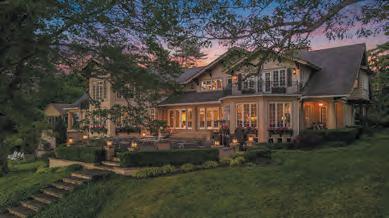







of distinction




Features






44Chic Retreat
Built in the 1970s, an Up North cottage gets a beautiful makeover for an active family.
By Khristi Zimmeth


















44Chic Retreat
Built in the 1970s, an Up North cottage gets a beautiful makeover for an active family.
By Khristi Zimmeth



























52Comfort & Joy
A custom log cabin in northern Michigan serves a family well.
 By Jeanine Matlow
By Jeanine Matlow

58Painting the Past One writer has a brush with history as he shares his colorful Mackinac tale.


 By Glen Young
By Glen Young
74Exploring Midland Get ready to discover plenty of welcoming surprises around this big small town the Dow family built.
 By Bill Semion
— LINDSEY SOUTHWELL
By Bill Semion
— LINDSEY SOUTHWELL
78Winter on the Border




























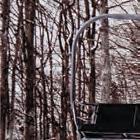























Historic Sault Ste. Marie lures outdoor adventurists to the U.P. with more than 120 inches of snow.











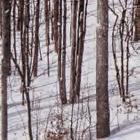


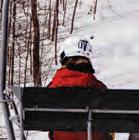
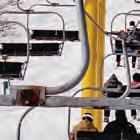

 By Amy S. Eckert
By Amy S. Eckert

82Dive in to Sweet Treats
You’ll be treading lightly with these desserts, which feature smart recipe substitutes.
 By Honey Murray
By Honey Murray
ON THE COVER
Bill Cutting sails in a Grand Traverse Ice Yacht Club race on Elk Lake near Traverse City.















Photo by Gretchen Dorian.

92“Variety is the spice during the winter months here, with plenty to do on and off the slopes.”PHOTO COURTESY OF SHANTY CREEK RESORT
Winter is the perfect time to sneak away for a rejuvenating getaway to Pure Ludington. Whether you are a winter enthusiast looking for outdoor activities that will enliven you like taking on snow-covered trails on a fat-tire bike, or just looking for a recharging getaway to reconnect and enjoy good food and craft beer, there is a place for you here. Don't hide from winter. Make plans to embrace all that a Pure Ludington winter has to offer!






16
The annual Michigan Ice Fest draws climbers and enthusiasts to scale Lake Superior’s frozen cliffs, and pontoon boats shine as a favorite of all generations.
By Mark Spezia and Chuck Warren
20 Get Outdoors
Traverse City’s Mount Holiday is perfect for families, and Grand Marais attracts female entrepreneurs.
By Giuseppa Nadrowski and Marla Miller
24 The Pike: Cruising U.S. 31
Yummy specialty pizzas and wine tastings add spice to west Michigan, and hard-
water sailors glide on sleek ice boats. By Jake Allen and Chuck Warren
28 Headwaters
Skiing and snowboarding duo carve out world records, one downhill run at a time.
By Dianna Stampfler
32 Studio Visit
Mosaic artist Michelle Sider captures the colors and spirit of Michigan.
By Megan Swoyer
34 Design Stars
Architects Brad and Theresa Angelini renovate and rearrange a Huron River home.

By Jeanine Matlow
36
Great throws and nautical nuances for the cottage, and what’s in for outerwear.
By Jamie Fabbri
88
Twin brothers add Mackinac Island Rum Co. tasting room to their distillery lineup.
By Ellen Creager
90 Dining Out
Bay Harbor’s NOMAD. celebrates a world of socially inspired taste treats designed around a shareable dining experience.
By Dianna Stampfler
92 Book It
For those seeking snowy
bliss, variety sets Shanty Creek apart from other resorts.
By Mike Spezia
97 Discoveries
I’ll take the old road and enjoy a little time traveling along northeast Michigan’s M-13.
By Bill Semion
12 Reflections
Explore!
By Megan Swoyer
100 Postcard
To capture January morning colors, this northeast Michigan photographer was ready at the Blue Hour.
By Shelley Goodlaski

“Every morning offers a beautiful landscape when you live on Lake Huron the sunrise side.”
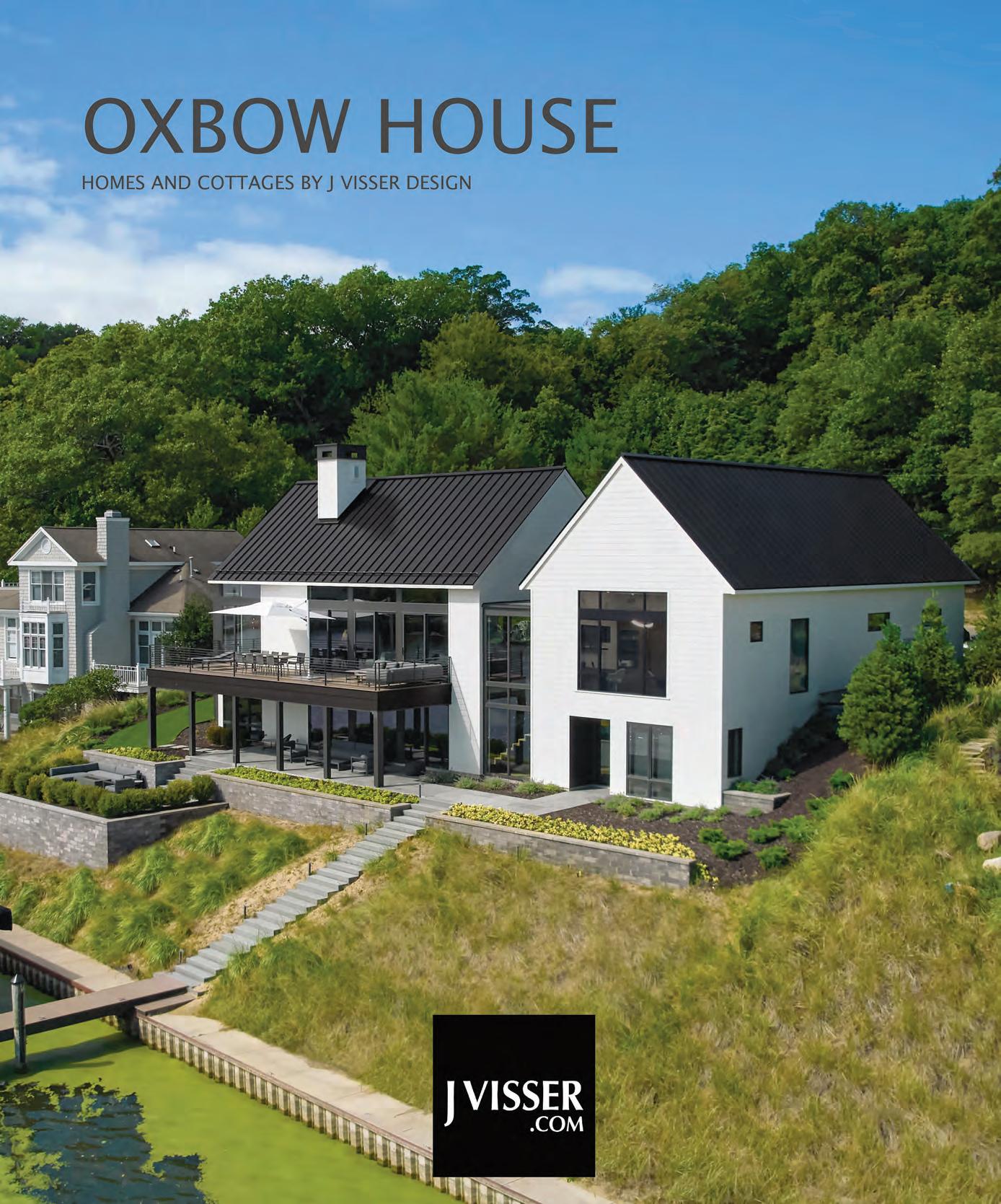
On a chilly morning not long ago, my husband and I set out for Alpena from our cottage to check out some shops and art galleries, and pick out some wall paint for our bedrooms. Walking the downtown streets, we started to feel those winter doldrums lift. It didn’t hurt that we stumbled upon a delightful little lunch spot tucked into the Center Building, which includes restaurants and a wine- and cider-tasting facility (Thunder Bay Winery). Boy, the cherry-spice wine was good! I inhaled the heavenly scents of homemade pizza and the heady aroma of various wines — was that cinnamon, almond, chocolate, vanilla, coffee? Why don’t we do this more often, I asked?
After lunch and browsing the used record, bike, and antiques stores downtown, we checked out a nearby coffee shop — the old-fashioned kind with folks of all ages gathered to chat, read, and play checkers, and where a creaky old floor added to the charm. I felt as light as the steamy coffee vapors that faded into the air around us. Light, in its many forms — light conversation, a light-filled ambience, and a feathery giddiness over simply being with my husband exploring new things.
Winter outings, especially at light-filled wineries, restaurants, and coffee shops, is a sure tonic for coping with an endless string of dark days. What a fun exploration! But it wasn’t over.
After the friendly paint-store stop, my husband made me guess where we were going next. The plan had been (or so I thought) to shop for a sofa, but he turned the car toward the outer edge of town. After about 10 minutes of winding roads, he pulled up to a sign that referenced Misery Bay. I had tried to find this remote spot with my son back in 2020, when we were told this location was a perfect place for spotting eagles, herons, and other birds. My son and I had tried to get there twice, but never found it — the Maps
app failed us “miserably,” we said to each other, laughing, as we ended up in neighborhoods and backyards.
We parked the car and immediately hit the trails, which were surrounded by beautiful scenery. When we arrived at the bay, we quietly looked out to expansive water, inlets, and a little island, all edged with pine trees and hardwoods. Classic Michigan.
Enter stage left: a heron! I grabbed my camera’s zoom lens quickly and, as I was photographing that great blue beauty against a wintry sky and forest-green tree tips, into view came a bald eagle! We wached the majestic creature glide above us and out over the bay. The giddiness of the day continued!
Extensive reports have been written on the association between one’s exposure to nature and health. Medical studies reveal that we all absolutely need to explore new things, hit the outdoors, and bask in nature’s bounty for our well-being. Exploring new territory has an impact on improved cognitive function, mental health, brain activity, blood pressure, and even sleep.
In this issue, we offer several suggestions for turning up your light absorption and exposure to nature. From checking out the annual Michigan Ice Fest along Lake Superior and exploring snowy Sault Ste. Marie’s offerings to schussing down the slopes of Mt. Holiday near Traverse City or Shanty Creek near Bellaire, we’ve got you covered.
You won’t find specifics about Alpena in the following pages just yet, but stay tuned! We’re still debating on how many of its bestkept secrets to write about in a future issue
Well, maybe I’ll reveal one surprise: The aforementioned Thunder Bay Winery Spiced Cherry wine is aswirl with spices like cinnamon, cloves, and nutmeg. And it’s best served warm!
Volume 18 | Issue 1 mibluemag.com
PUBLISHER: Jason Hosko
EDITORIAL
EDITOR: Megan Swoyer
CONTRIBUTING TRAVEL EDITOR: Ron Garbinski
COPY EDITOR: Anne Berry Daugherty

WRITERS: Jake Allen, Ellen Creager, Amy S. Eckert, Jamie Fabbri, Shelley Goodlaski. Jeanine Matlow, Marla Miller, Honey Murray, Giuseppa Nadrowski, Bill Semion, Mark Spezia, Dianna Stampfler, Chuck Warren, Glen Young, Khristi Zimmeth
CREATIVE DIRECTOR: Lindsay Richards
ART DIRECTOR: Justin Stenson
SENIOR PRODUCTION ARTIST: Stephanie Daniel
JUNIOR ART DIRECTOR: Steven Prokuda
CONTRIBUTORS: Gretchen Dorian, Brad Dykstra, Jeff Garland, Shelley Goodlaski, Jeannie Kain, Kyle Kelly, Jean Lannen, Paul Petersen, Bill Semion, Eli Sider, Beth Singer, Dan Speckman, Sara Wright
SALES
ADVERTISING INQUIRIES: advertising@hour-media.com
ACCOUNT EXECUTIVES: Todd Anderson, Nick Irwin, Jessica Laidlaw, Maddy Messerly, Aaron Ogg
TO ORDER REPRINTS: Receptionist, 616-459-4545
PRODUCTION DIRECTOR: Jenine Knox
SENIOR PRODUCTION COORDINATOR: Jill Berry
PRODUCTION ARTIST: Jonathan Boedecker
ADVERTISING COORDINATORS: Amanda Kozlowski, Haylee Mozug
GRAPHIC ARTIST: Jim Bibart
WEB
DIGITAL STRATEGY DIRECTOR: Nick Britsky
DIGITAL DEVELOPMENT MANAGER: Matthew Cappo
DIGITAL DEVELOPMENT SPECIALISTS: Jim Bowser, Marissa Jacklyn, Luanne Lim, Kevin Pell
VIDEO PRODUCER: Nicole Toporowski
VIDEO EDITOR: Taylor Lutz
DIGITAL STRATEGY MANAGER: Travis Cleveland
DIGITAL MEDIA ASSISTANT: Robyn Banks
IT IT DIRECTOR: Jeremy Leland
CIRCULATION DIRECTOR OF AUDIENCE DEVELOPMENT: Geralyn Wilson CIRCULATION MANAGER: Riley Meyers
CIRCULATION COORDINATORS: David Benvenuto, Jaz’myne Jones, Cathy Krajenke, Rachel Moulden, Lisa Sawyer, Michele Wold
CIRCULATION CUSTOMER SERVICE: 866-660-6247
MARKETING AND EVENTS MANAGER: Jodie Svagr
COMMUNICATIONS AND EVENTS LEAD: Cathleen Francois
MARKETING AND EVENTS COORDINATOR: Jaime Presnail
DIRECTOR OF BUSINESS OPERATIONS: Kathie Gorecki
PUBLISHING AND SALES COORDINATOR: Kristin Mingo

ASSISTANT OFFICE MANAGER: Natasha Bajju
SENIOR ACCOUNTING ASSOCIATE: Andrew Kotzian
ACCOUNTING ASSOCIATE: Sammi Dick
CEO: Stefan Wanczyk | PRESIDENT: John Balardo
Michigan BLUE magazine is published quarterly by Hour Media. Publishing offices: 401 Hall St. SW, Suite 331, Grand Rapids, MI 49503-5098. Telephone 616-459-4545; fax 616459-4800. General email: info@hour-media.com. Copyright ©2023 by Gemini Media. All rights reserved. POSTMASTER: Send address changes to Michigan Blue magazine, 1965 E. Avis Dr, Madison Heights, MI 48071. Subscription rates: one year $14.95, two years $24.95, three years $34.95, U.S. only. Single issue and newsstand $5.95 (by mail $8.95). To subscribe or to order back issues, please contact Circulation at 866-660-6247. Advertising rates and specifications at mibluemag.com or by request. Michigan Blue magazine is not responsible for unsolicited contributions.

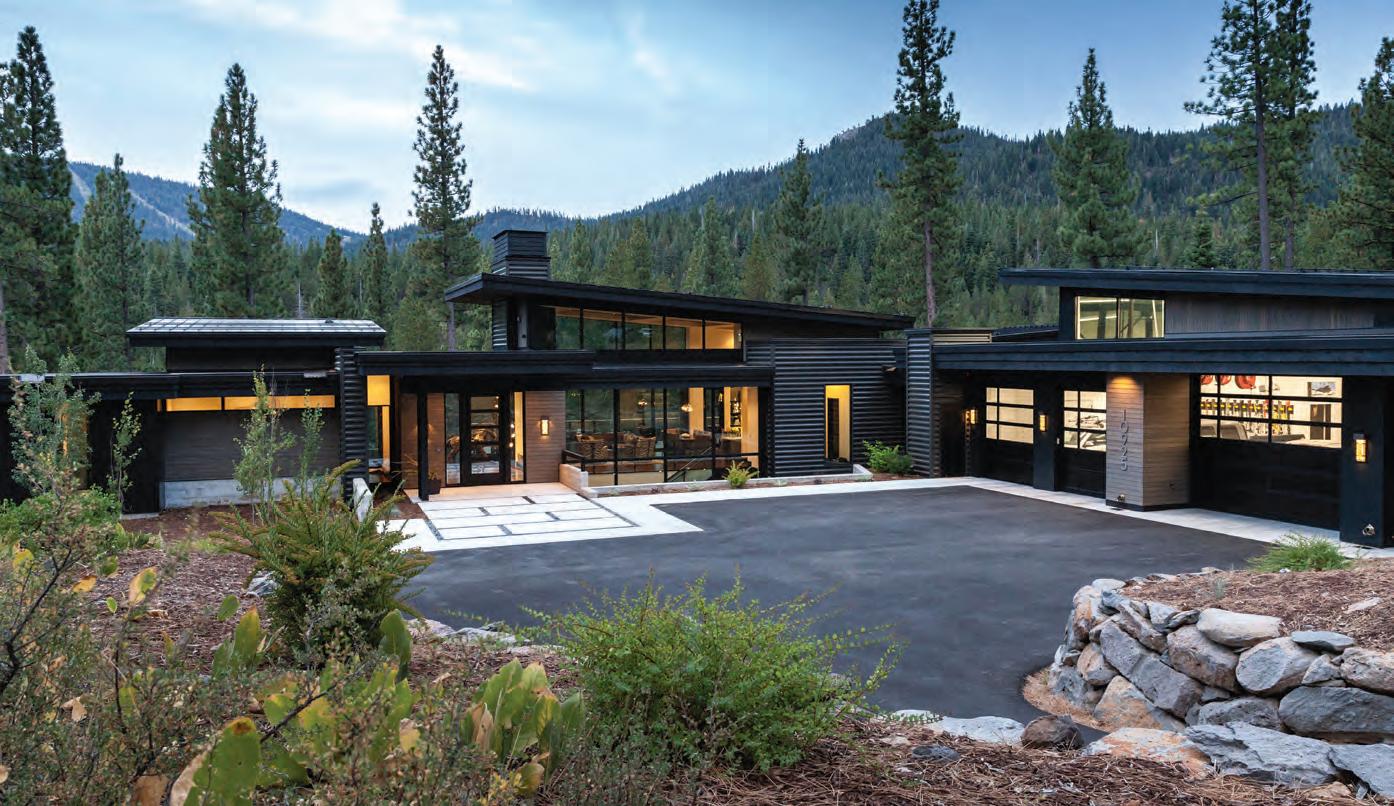

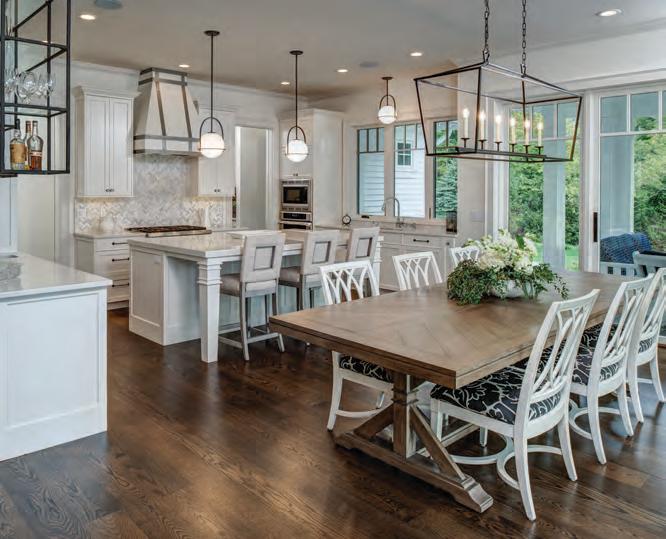

Michigan’s big tree winners, Belle Isle conservatory’s facelift, and a Treetops Resort ski update.
16
Annual Michigan Ice Fest draws worldfamous climbers to Munising, and tips on how to buy a pontoon.

Traverse City’s Mt. Holiday expands with year-round fun, and Grand Marais women establish new roots.
24
Head out on a tour of west Michigan, and learn about the thrills of wind-powered ice boating.
A skiing and snowboarding duo set out on slopes around the state in pursuit of a world record.
Exploring Michigan: Tips, trends, and tidbits
WEEKDAY FUN: For the first time, Treetops Resort in Gaylord now is open for midweek skiing, boarding, tubing, and trailside activities. Snowmaking capacity has tripled, the Extreme Tubing park has doubled in size, and a Skiable Feast returns with five trailside buffets. treetops.com
BIG TREES: An Eastern cottonwood tree in Washtenaw County submitted by Aidan Presnell, competing in the under-15-years-old category, won the grand prize for the largest tree in the 2020-2022 Michigan Big Tree Hunt, sponsored by ReLeaf Michigan. It measures 308 inches around (more than 25 feet). The 15th biennial contest attracted more than 650 entries from 79 of the state’s counties. Big Tree Hunters in the 16-years-or-older category, Mike Antoszewski and Paul Funk, both won grand prizes for submitting two Eastern cottonwoods in Monroe County measuring 301 inches around.
The Eastern White Pine category was another two-way tie at a 181-inch circumference. The were submitted by Tom Hollis and Payton Rue from Clinton County, and Nicholas Hansen from Marquette County. releafmichigan.org
FACE-LIFT: The Anna Scripps Whitcomb Conservatory at Belle Isle Park in Detroit, designed by Albert Kahn, will be closed until May 2024 while undergoing a $10-million renovation. During the renovation activity, an envelope wrap will surround the facility. The outdoor gardens will be closed until May 2023, when spring blooms make their appearance.
– Compiled by Ron GarbinskiHave news that pertains to Michigan travel and exploration? Send a note to Meganr@WaterlooGroup.com.
 By Mark Spezia
By Mark Spezia
As winter blankets the Upper Peninsula, the water seeping around, over, and through the iconic sandstone cliffs — some more than 200 feet high of Pictured Rocks National Lakeshore and nearby Grand Island creates awe-inspiring ice formations.
The ice takes the shape of curtains, columns, pillars, and even dryer hoses, as all that moisture oozes through the porous rock above Lake Superior. Many picturesque waterfalls freeze solid, as well.
These frozen wonders will take center stage Feb. 8-12 when more than 1,000 ice-climbing enthusiasts of all ages, backgrounds, and ability levels gather for the annual Michigan Ice Fest in Munising.
“Those cliffs rising so high right out of Lake Superior, and all the beautiful formations that appear, make Munising a phenomenal iceclimbing destination because we also have dozens of waterfalls that freeze, and ice is everywhere,” says Bill Thompson, organizer
of the Ice Fest, which celebrates its 31st anniversary in 2023.
“Even experienced, famous climbers coming here for the first time are amazed. They usually can’t believe it’s Michigan,” he adds.
Count Conrad Anker, one of America’s most accomplished mountaineers, among the believers. Summiting Mount Everest three times and establishing new climbing routes around the world, including the extremely difficult Shark’s Fin in the Himalayas of northern India, are just a sample of his achievements.
Anker first attended Ice Fest in 2014 as part of a team making “National Park Adventure,” an IMAX film celebrating the National Park Service’s 100th anniversary. He has returned nearly every year since, to test himself on the formations while helping others do the same.
This year, Anker is conducting a clinic entitled Expedition Primer: Denali 101, which covers what it takes to prepare for climbing North America’s highest peak. He’ll also be signing Yeti brand cups and water bottles, as
well as copies of “The Call of Everest,”a book he co-authored.
“The beauty of ice-climbing is that every area is unique and, every day, experiences change,” Anker says. “The hardwood forest, the expanse of Lake Superior, the sandstone bluffs running with pigment from the iron all combine to make northern Michigan ice unique in the world.”
Angela Limbach is a member of the United States World Cup ice-climbing team. She finished among the top six at the North American Ice Climbing Championships, and was in the top 22 at the World Championships in both the speed and lead categories last year. She’s been a part of Ice Fest since 2016, and will be providing instruction again this year.
“Ice-climbing in mountainous places has its own joy and beauty, but there’s little that can compare to lowering over the cliff edge with (Lake Superior’s) waves smacking the wall below,” she says. “The crashing waves, ripping wind, bullet-hard ice, low temperatures, and feeling like you’re in a snow globe can make the more challenging climbs on the shore brutal, but also beautifully wintery and fantastic.”
Thompson, who has attended every Ice Fest as a participant or organizer, has witnessed the event grow from a handful of friends in search of the most thrilling iceclimbing around Munising to more than 1,100 people last year.


Among other featured athletes this year are Barry Blanchard, a legendary master of difficult first ascents around the world, and Michigan native Sam Elias, one of the few climbers who has summited Mount Everest and free-climbed Yosemite National Park’s El Capitan.
Blanchard will lead a screening of a film about his life and sign copies of his autobiography, “The Calling: A Life Rocked By Mountains.” Elias will conduct presentations on the fusion of art, climbing, and woodblock printmaking.
Renowned mountain guide Emilie Drinkwater will be making her Ice Fest debut and plans to deliver a presentation on leading an historic all-female climb to the highest point in Afghanistan.
Ice Fest boasts numerous courses and clinics, an extensive gear raffle, and the
chance to meet representatives from many leading outdoor apparel and equipment companies.
Thompson emphasizes that the event offers perhaps the best and safest opportunity for anyone wishing to try iceclimbing for the first time or improve their skills and tackle more challenging climbs.
“This is the place to just go out and ice climb, to see if it’s for you, because it would be dangerous to try to figure what equipment is needed and do it on your own,” he says. “Ice Fest offers world-class instruction and climbs for all skill levels. We provide all the necessary equipment and guided climbs (transportation provided) from near downtown Munising to Grand Island and the Pictured Rocks backcountry.”
Some of the most popular formations are off Sand Point Road, not far from Munising, and include the Dryer Hose, a 35-foot frozen waterfall surrounded by a half-bowl of sandstone, and No Boundaries, a 25foot frozen waterfall that climbers can walk behind.
There’s also The Curtains, a 200-footlong, 30-foot-high sandstone ledge draped in white and blue ice.
Farther away are Dairyland, a more than 150-foot climb over a wide formation of ice with a great view of Lake Superior, and HMR — 160 feet of rust-colored vertical ice hanging directly over Lake Superior.
This page: Ice climbers from all around, including some world-class athletes, participate in a variety of exciting climbs and related activities. Opposite page: Spectacular ice formations along the Pictured Rocks National Lakeshore and Grand Island are challenging sites for the daily organized climbs, and how-to instruction.
Each Ice Fest day concludes with an afterparty and the chance to mingle with some of the elite climbers.
Ice Fest’s popularity has soared during the past decade thanks, in part, to social media postings and the 2016 release of both the National Park Service’s film, “Ice Capades: The Winter Wonderland of Pictured Rocks,” and “The Michigan Ice,” an 84-minute film about the event directed by Michigan resident Aaron Peterson.
PLAN IT! Michigan Ice Fest michiganicefest.com
Pontoon boats, once considered a novelty item, now shine a s a favorite of older and younger generations alike
By Chuck WarrenAs Michigan’s boating season has cooled way down, boat show season is heating up across the state and watercraft dealers are making plans to show off their latest products.


Over the past decade, an unlikely boating industry segment has unexpectedly outpaced all other types of recreational vessels: pontoon boats. A 2021 study by market reporting company Stratview Research reveals that pontoon boats now represent about 20 percent of the boating market.
With sales expected to grow by 4 percent this year, while other boat types might see half of that figure, pontoons have become a hot item among buyers looking for a comfortable, versatile vessel.
No longer resembling a front porch with an outboard, pontoons have evolved dramatically since they first appeared on Great Lakes waters in the early 1950s. Today’s pontoons are no longer stuck in the entry-
level market; they’re well represented all the way up to the luxury markets. Affordable models are available for under $25,000, while high-end boats can hit prices above $200,000.
Much like shoppers in the new car and truck markets, today’s pontoon buyers are faced with an overabundance of choices. Although they’re versatile by nature, before searching for a pontoon it’s recommended that you decide what you want the boat to do, as someone looking for the ability to enjoy a leisurely cruise along the shoreline may not need the same features as someone who wants the horsepower to pull skiers and wakeboarders.
Built on a foundation of twin or triple tubes, each hull type can support different needs. Twin-tube models can’t handle the weight and torque of many higherhorsepower engines and are generally rigged with smaller outboards for basic cruising, swimming, fishing, and exploring. Tritoons, much stronger boats made with three tubes instead of two, can handle the demands of
power packages like twin 450 horsepower outboard engines that can push boats more than 70 mph.
Twin-engine tritoon models are aimed at the water sports crowd — boaters who are looking for the ability to tow a wakeboard or skier while still owning a vessel that’s capable of taking 10 to 15 passengers on an evening cruise.
Other important questions are: Where will the boat be used? How many people can it accommodate? What options are critical, and which would be nice to have?
And, of course, what do you want to spend?
John Conrad, sales manager at Elk Rapids Marina, regularly introduces buyers to Manitou, Montara, and Avalon brand pontoons. He advises that potential buyers educate themselves on the different manufacturers and models before committing to any purchase. “Go look on their websites at what you want,”Conrad says,“and then go put your hands on the products and arrange to go for a ride when it’s possible.”
With so many dealers to choose from, Conrad also believes finding the right sales team is important. “Find someone who will help you buy a boat, not just sell it to you,” he says.
As a new Michigan boat show season kicks off with the 65th annual Detroit Boat Show at the city’s downtown Huntington Place convention center Jan. 14-16 and 19-22, boat shoppers have an opportunity to see a large selection of new pontoon brands under one roof.
Other shows around the state include The Lansing Boat show at Lansing Center from Feb. 3-5, and The Grand Rapids Boat Show at DeVos Place Feb. 15-19. There are additional shows in a variety of locations around the state, such as Novi and Traverse City.
With new features like color-changing LED lighting, touchscreen navigation and audio control systems, and accessories for the connected crowd such as inductive chargers and strategically placed USB ports for charging mobile devices, many new models can be found with enough standard features to satisfy buyers without driving up the price.
However, the evolution of the pontoon boat has also created lots of optional features. Popular extras that enable a buyer to spend more and customize their boat to better

fit their needs or to represent their own personal style include diving boards, privacy stations that can double as bathrooms, and underwater lighting.
With three of the Great Lakes bordering the state’s more than 3,200-mile-long shoreline and countless inland lakes big enough to support a pontoon boat, it’s easy to see why so many buyers choose to pass over more traditional V-hull power boats for the ability to take more people along to enjoy a day on the water.
New pontoon boats are fast, big enough to tackle a day on the Great Lakes, and

versatile enough to support a day of fishing or wakeboarding. They’re also luxurious enough to accommodate a group of sunset cruisers equipped with fine wines, craft brews, and tasty treats.
The pontoon boat has become a favorite of buyers from older and younger generations alike. No longer considered a novelty item, the floating porch is here to stay.
Michigan Boating Industries Association mbia.org
This page: Tritoons (top) are aimed a t the water sports crowd. New toons (below) can be customized to personal tastes. Opposite page: Boat shows are a great place to check out the many brands and options available.Mt. Holiday expands from a neighborhood ski hill to offer a host of year-round activities for all ages
By Giuseppa NadrowskiIn a quiet Traverse City neighborhood about a mile east of Grand Traverse Bay, there’s a local gem that continues to expand its four-season recreational offerings.
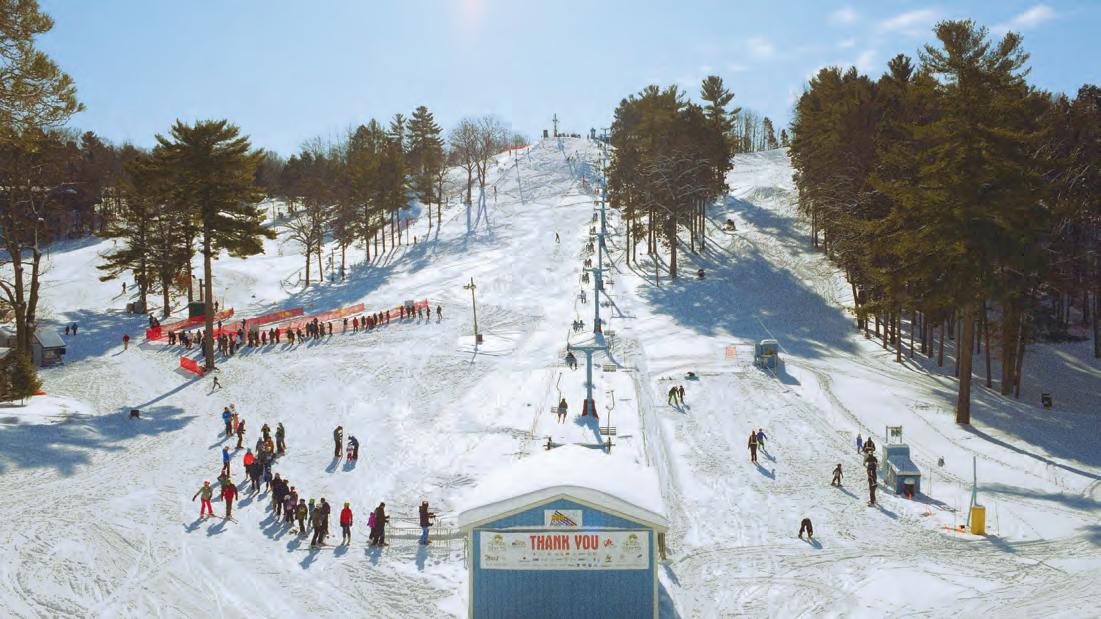
Once just a fun place to ski, Mt. Holiday’s options now include snowboarding, tubing, zip-lining, hiking, mountain biking, and more. It’s become a year-round family tradition for many.
It all started in 1949 when a group of business leaders looking for a fun wintertime destination received permission to create a ski run on state-owned land. Holiday Hills, as it was called, was thus established.
“Volunteers, prison-labor services, and donations” helped build the hill, according to
Michelle Pearson, president of Mt. Holiday’s board of directors.
In 1985, Warren and Sue Brosch purchased the hill and, under their private ownership, chairlifts and a terrain park were added. Soon after Warren’s passing in 1999, Mt. Holiday was put up for sale. Out of fear of it being converted into a residential development, a group of community volunteers formed Mt. Holiday Inc., a nonprofit corporation. They set a goal of raising the $1.5 million that would allow them to purchase the approximately 44 acres and open it back up to the public.
In the early 2000s, the residents were able to purchase Mt. Holiday, and they turned the resort into a 501(c)(3) nonprofit.
“Everybody had grown up with it and they realized what a gem it was to have in a town of our size. And in a neighborhood. And to have everything from ski lessons to ski racing, to all (sorts of) events. And all the memories that it’s generated (through the) generations,” says Nate Noyes, Mt. Holiday’s executive director.
Noyes fell in love with Mt. Holiday’s location and charm when he and his family first went skiing there in 2008.“We had moved to Traverse City and my boys were little, and we happened to live in the neighborhood. We just thought it was the coolest thing. It was the perfect size for two little boys, my wife, and me. It was very affordable.”
Today, Noyes guides the culture of the resort. “I want to make sure our mission stays at the forefront of what we’re doing — and that’s to connect families with four seasons of affordable outdoor recreation,” he explains. “I want to keep it affordable, and I want to make sure that it’s available to everybody.”
A scholarship program was created so “we can give free lift tickets or give out rental skis, and get (people) out there so they can enjoy their friends and connect, as well,” Noyes says.
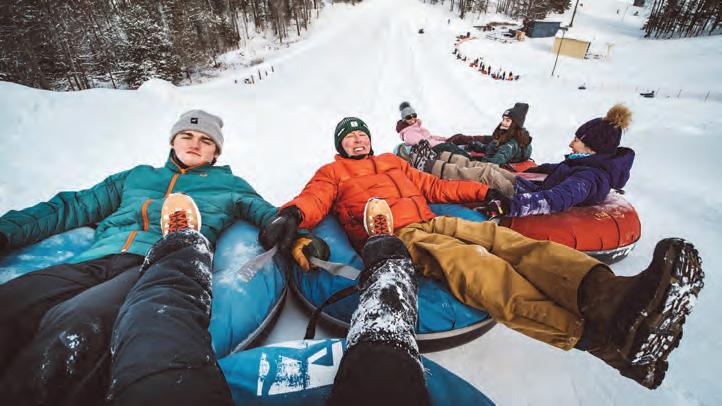
Mt. Holiday is home to The Kiwanis Record-Eagle Ski & Snowboard School. “We make that about as dirt-cheap as we can,” Noyes says.
Participation in the adult ski patrol program and a junior ski patrol program (launched by Pearson and geared to local youth ages 12 to 18) offers residents a way to get a free ski pass in exchange for their time volunteering.
“We’re making it so a family can come out and not spend a lot of money,” says Pearson, who has been on the ski patrol for more than 20 years. “Skiing and snowboarding are one of the last family sports. For my family, we ride up on the trails together, but then we split apart. It’s a family sport, but individual at the same time,” she adds.
Until recently, Mt. Holiday only offered winter-based recreation: skiing and snowboarding. After the nonprofit took over, two tubing runs (complete with an express lift to the top) were built. A terrain park includes several trick-based features such as rails and jumps.
Among its many youth programs, Mt. Holiday hosts the Holiday Race Team — a learn-to-race program for elementary to junior high students.
As an ever-expanding four-season park, activities available in the warmer months now include mountain biking courses, a mile-long hiking trail, and zip-lining. The T-Bar and T-Bar Lounge are open year-round for refueling before and after rides.
Mt. Holiday’s newest program, Base Camp, is a class for those ages 5 and up who
want to learn how to do more, including aerial maneuvers, safely and correctly on their bikes.

“We’re developing that more and more. This is a camp that’s going to be year-round versus just in the summer,” Pearson says.
Annual events such as the much-loved Mud, Sweat, and Beers bike race in the spring, which attracts around 900 riders, help to support the facility’s programs, scholarships, infrastructure, and more.
An ongoing capital campaign will help modernize its chairlifts, snowmaking capabilities, and other older amenities. “It will allow us to open earlier, stay open later, and just be a much more robust ski hill for everything from lighting to lifts. We really don’t generate a lot of revenue. We’re very fortunate to have a generous community that helps us with those types of things,” Noyes says.
Two tubing runs (above) w ith an express lift to the top, and the new Base Camp bike riding training facility (left), add excitement to the year-round activities at Mt. Holiday in Traverse City.
He believes it’s all about “giving the people, the families, the kids of this area a place to go where they connect with one another, where they make memories, where they find friendship, where they find camaraderie. Especially with kids,” he says.
“They need a place outside of school and sports where they can meet up with their friends. Now that I’m a dad and I’ve got two teenage boys, I look at this as something special for the mom and the dad and the grandparents, because that’s where they can take their kids and still be connected to them. It doesn’t matter if you’re 10 or you’re 80; everyone can get out there and enjoy the snow.”
PLAN IT! mt-holiday.com
Asidewalk sign offering snowmobilers free coffee and cookies lured my group inside Grand Marais Outfitters on a blustery Upper Peninsula winter evening. Then the blue butterfly-shaped agate art and a cool flag of the region’s Crazy 8 snowmobile trails hanging in the window caught my attention.
That’s when owner Jeannie Kain struck up a conversation from behind her cash register about chasing a dream that led her to the shores of Lake Superior. Kain explains that she made several trips across Michigan’s U.P. looking for business opportunities, but she’d never made her way as far north as Grand Marais until a real estate agent called her one day about a retail store for sale with an apartment above it.
Kain packed her car and headed to the bayside community — known as the eastern gateway to Pictured Rocks National Lakeshore — in September 2021. “I said, Where the heck is Grand Marais?” she recalls. “(The real estate agent) described the area and the business. Basically, I came to town and looked at it, and made an offer on the store.”
Kain liked that she could live upstairs in the renovated historic building, which dates back to the 1890s. She also felt the call of the picturesque community, which boasts a population of about 300 residents.
“Grand Marais is such a quaint little town,” Kain says. “You can drive right up to

the shore and jump in the water if you want to. That’s what I thought made it so special when I came here. I was so impressed by how well-kept the town is, how friendly everyone is, and how accessible everything is here.”
Settled in the early 1860s, Grand Marais boomed because of its fishing and lumber industries. Today it’s a year-round oasis for outdoor adventurers, thanks to its direct access to Lake Superior and nearby national park trails and attractions. The area draws hikers, paddlers, and tourists who hike the North Country Trail, fish and kayak local lakes and rivers, and explore the region’s waterfalls and rock-filled beaches.
In the winter, the town is transformed into a snowy wonderland. Dog sledders, snowshoers, winter campers, and snowmobilers brave blizzards to play in the region’s vast stretches of wilderness.
Grand Marais Outfitters has the welcome sign out, and in the winter months Kain always serves hot coffee and cookies. The store sells quality outdoor apparel, equipment, and supplies for locals, tourists, sportsmen, and athletes visiting the region. Kain also rents
Grand Marais, its icy surroundings, and nearby attractions celebrate outdoor winter adventures along the shores of Lake Superior.
snowshoes for people who want to explore area trails.
“It’s always been an outfitters and outdoor apparel store, and we sell items so you can enjoy all four seasons of weather in Grand Marais,”she says. “My goal is to focus more on outdoor sports, fishing supplies things that will enhance other aspects of the outdoors.” She also holds packages for hikers who want to ship supplies there ahead of time for long-distance hikes on the North Country Trail.
Kain also showcases local artists, Michiganmade products, and Upper Peninsulathemed clothing, gift items, and souvenirs. Mostly a one-woman show, she continues to add items to her online store and will take phone orders and ship the goods. Agate art, wine stoppers made from tumbled rocks, and agate necklaces are among her wares.
Grand Marais attracts female en trepreneurs w ho cater to their U.P. community’s fourseason Lake Superior charms
Left: Jeannie Kain fell in love with the community and opened Grand Marais Outfitters in 2021. Below: The Inn at Lake and Randolph is a charming fivebedroom B&B.
Like many up north proprietors, Kain was ready for a change after working at the University of Michigan for nearly 30 years. She provided care for her aging parents and raised four children, who are all grown now and supported her move.
During the pandemic, she says, “I think everyone went through an identity crisis or introspection about what was important and what they wanted to do with their life.”
By Thanksgiving 2021, Kain retired, sold her house in Romulus, and took possession of the building. After surviving her first year and first winter, Kain says she’s learned a lot about running a retail store and living in a remote place that has snow into April.
“In some ways, it hasn’t gone anything like I thought it would — but overall, it’s been wonderful,” she says. “The town has been very welcoming and super nice. Overall, I’d do it again in a heartbeat.”
The owner of The Inn at Lake and Randolph, 33-year-old Taylor Stice, is another female entrepreneur who recently moved to Grand Marais; she left Nashville, Tenn., to pursue her dream of owning a bed and breakfast.


Stice says she grew up visiting her grandparents in Grand Marais, where her grandmother and mother now live, and she returned in 2019 to open a B&B in her grandparents’ historic home.

The home was built in 1887 in Seney and was moved north at some point, Stice says. It features five bedrooms, three bathrooms, and a full chef’s kitchen with a large community dining table overlooking the bay, where breakfast is served daily. Guests can enjoy sunrises and sunsets or walk to the bay, beach, and downtown businesses.
Kain and Stice agree that the region offers great opportunities to enjoy the outdoors and experience true up north adventure.
“Grand Marais is a wonderful destination year-round, from spring waterfall-chasing to summer beach days, fall colors, and winter dog-sledding,” Stice says. “The outdoor activities are endless. We have miles of trails for every sport snowmobiling, cross-country skiing, snowshoeing, hiking, biking, and ATVing, not to mention the Pictured Rocks National Lakeshore with stunning rock formations and hidden beaches.”
G rand Marais Outfitters grandmaraisoutfitters.net The Inn at Lake and Randolph lakeandrandolph.com
West Michigan rates as a paradise for foodies, especially for those with a taste for wine and pizza. Traveling food-lovers are in luck, as both family-owned pizza shops offering specialty pies and dozens of vineyards dot the coastline, from the southwest corner of the state all the way up to the tip of the mitt.
Pangea’s Pizza offers a tasty mix of specialty creations, all with a distinctive blend of flavors and extra touches.

including the loaded potato pizza, which comes with cheese, thinly sliced potatoes, scallions, bacon, and white truffle oil. Other specialty pies include the BLT, BBQ chicken, chicken Alfredo, and Caribbean jerk.
• In downtown Traverse City, one local favorite is Pangea’s Pizza. “It’s definitely become a pretty good spot for visitors and locals alike, particularly in the summer,” says owner Chris Mohrhardt.
The restaurant is known for its specialty pizzas
“We bring a unique blend of flavors and take those extra steps,” Mohrhardt adds. “You can taste it in our food. Instead of bringing cheese in bags into the kitchen, we shred the cheese fresh, onsite, from blocks. We make the sauce fresh, we make the dough fresh. It gives people that flavor profile they want from a pizza, and we do it consistently well.”
Pangea’s has room for more than 130 patrons on the roof deck and bar, which offers views of downtown, the marina, and portions of Grand Traverse Bay.
• Bowers Harbor Vineyards, about 10 miles north of downtown Traverse City, is Old Mission Peninsula’s secondoldest winery.

“We’re pretty well known for our dog wines,” says tasting room manager Bethany Poineau. “Those wines are named after the owners’ previous dogs.”
The winery’s 2021 Cooper White is named after the family’s beloved Bernese mountain dog, while the Brix Sparkling Wine is bubbly and friendly, just like the family’s former dog, Brix, who greeted customers in the tasting room.
“It’s a family-owned vineyard, so the family lives onsite,” Poineau says. “The son planted a lot of the vines on the property himself, with his parents. There’s a lot of family history here. It used to be a horse farm and a working farm.”
Bowers Harbor Vineyards, which produces between 22,000 and 28,000 cases of wine annually, gives visitors a feel for the agriculture aspect of the business, in addition to views of Grand Traverse Bay. The estate totals 50 acres and the varietals grown include Riesling, Chardonnay, Pinot Grigio, Merlot, Pinot Noir, Cabernet Franc, and Cabernet Sauvignon.
• In Ludington, the Chuck Wagon is another family pizza business known for its excessive toppings. It makes its own sauce and dough, and grates its own sausage. Everything is homemade. The restaurant’s most popular item is its meat pizza with pepperoni, ham, sausage, bacon, and burger.

• Three miles away you’ll find Love Wines, which uses local fruit and grapes grown on-site at the lakeside winery and tasting room. Its offerings include Muscat, Merlot, Marquette, and dessert wines including Classic White, Michigan Marquette, and Driftwood.
Love Wines’ Toes in the Sand, a strawberry-peach lemonadestyle wine, is its signature blend and is affectionately known as “Ludington Lemonade.”
• When in southwest Michigan’s Union Pier, check out the Round Barn Tasting Room and Union Pier Social.
“What’s really great about the Round Barn, and what I love, is we have something for everyone — from your really sweet wines to drier options,” says Meagan Veldman, social media and public relations representative for Moersch Hospitality Group. “There’s something that appeals to everyone. You can find a new favorite every time.”
Black Walnut Cream, a dessert cream wine, is a favorite, along with the canned sangrias and craft brews.
Union Pier Social offers great food, a family atmosphere, and live music. The restaurant has a large menu that includes 12-inch Italian-style pizzas with a variety of sauce bases. Pizza options include the Margherita; The Jerk, with chicken and BBQ sauce; chicken bacon ranch; and cheesy peasy, with a blend of mozzarella and provolone cheeses.
top: Bowers Harbor Vineyards i s known for its history, wines named after family dogs, and views of Grand Traverse Bay. right: The Chuck Wagon makes its own sauce and loves to pile on the toppings.
• Up north in Mackinaw City, fun picks are Mama Mia’s (home to a free Mackinaw Bridge museum) for pizza and Nicholas Black River Vineyard & Winery for wine.
Mama Mia’s gives guests a build-your-own-pizza option in addition to its menu of specialty pizzas, which includes the deluxe — two meats of your choice, mushrooms, onions, green peppers, and green olives. A Philly pizza with roast beef, onions, green peppers, mushrooms, and cheddar cheese sauce, as well as the cheeseburger and sweet tango pizzas, round out the choices.
Nicholas Black River Vineyard & Winery, located within walking distance of Mama Mia’s, offers a variety of wines and free samples. Its selections include the Mighty Mac, which is a semi-sweet, smooth, and fruity red wine with hints of Greek spices, and the Old Mackinac Point Lighthouse Riesling, a new semi-sweet white wine with tropical fruits and a crispy finish.
What a delightful way for foodies to taste their way around west Michigan!
When summer is over and the water becomes too cold to enjoy, most Michigan boaters wrap up their vessels and store them away for the winter. Until the ice melts, the Michigan boating season is over.
But not for one group of sailors, who believe frosty weather only makes their season better: ice boat racers.
Ice boats, also called ice yachts, are small, fast sailing craft perched on three runners. They can reach speeds of 60 mph or more by using the power of “apparent wind.”

Found in the Netherlands as early as the 17th century, ice boat racers first appeared in the United States on New York’s Hudson River in the late 1700s. The practice gradually began to spread, and ice boat racing made its way to Michigan in the late 1800s although interest fell off with the introduction of motorized boats.
When the sport caught the attention of Detroit News President William E. Scripps in the mid-1930s, the newspaper ran a contest to develop an inexpensive, easy-to-build ice boat for the general public. With the birth of the model DN, named in honor of The Detroit News, interest in ice boating took off in Michigan and sporting clubs appeared across the state.
Although the DN is the most common, ice boats are found in several different designs. They’re primarily divided into two categories, determined by a boat’s bow or stern steering ability. Ice boat designs such as Nite, Skeeter, Renegade, Ice Optimist, and the DN are raced across many of Michigan’s frozen lakes when winter conditions are right.
Today, the thriving sport attracts competitors, thrill-seekers, and those who just love to sail. Calling themselves “hard water sailors,” clubs organize racing events and regattas when the weather cooperates.
Ice boats come in several different designs, ranging from classic wooden styles to sleek solo ones. The boats are lightning-fast on their three runners (similar to the blades on ice skates) when the conditions on frozen inland lakes are just right.
When the lakes freeze, hard-water sailors hop on their sleek ice boats and glide across the frozen expanse, reaching speeds up to 60 mph
Although some events can be fiercely competitive, members can just as often be found speeding across the ice just for fun. Gail Turluck, a member of the Gull Lake Ice Yacht Club, near Kalamazoo, says the sport keeps her love of sailing alive. “It’s all about sailing,” Turluck says. “I don’t care if it’s hard water, soft water, big boat or small.”
For Ron Sherry, ice boating is more than a sport. It’s also his business. Sherry’s father, a Lake St. Clair ice boat racer, and the winner of more than 30 ice boat racing championships in the U.S and around the world, introduced his son to ice boating when he was 9 years old. Sherry won his first major race at age 12.
Today, Sherry’s company, Composite Concepts, constructs custom ice boats for racers. He also builds and supplies components such as hulls, masts, and runners. “I build parts for all kinds of boats,” he says, “but DNs are what I do the most.”
Ice boats, including the ubiquitous DN, seem lightning-fast when conditions are right. Sherry maintains that safety should be the No. 1 concern, whether racers are just starting out or have been in the sport for years. For beginners, safety considerations should never be disregarded. “Don’t go sailing the first time in high winds. Go with a group that’s experienced, as there’s safety in numbers,” he says.
Ice boats fly across the frozen surface on three runners, similar to ice skate blades, which are carefully sharpened to reduce friction. With so little contact between the boat and the ice to create drag, the boats
Above: Local ice boat clubs host races and other events throughout the winter. Newcomers often are encouraged to attend. Below: The thriving sport attracts competitors, thrill-seekers, and those who love to sail. It even can be a fun family outing.

regularly attain speeds that are three or four times that of the actual wind. At that speed, an ice fisherman’s hole or other imperfection on the surface can quickly end a racer’s day. For that reason, racers regularly relocate to find the best, and safest, ice for the day’s events.
The ice must also be thick enough to support the entire group of boats and people, so club scouts regularly inspect area lakes to find the right conditions before alerting other club members to the perfect destination.
“We try to find the safest ice,” Sherry says. “That means we often pick up and go to another location. If you’re not willing to do that, you need to find a different sport.”
Many clubs love to introduce newcomers to the sport. At their annual kick-off meeting last fall, Gull Lake Ice Yacht Club members announced an event called Ice Boats on the Bay, scheduled to be held at the south end of Gull Lake in February.

“It’s like an open house for ice boats,” Turluck explains. “People can come see the boats and learn about the sport.”
I nformation a bout ice boating in Michigan can be found on local club websites such as gulllakeiyc.org, iceboatracing. com (Composite Concepts), and the Ice Boating in Michigan and Ohio Facebook group page.
Last winter, skier Kyle Kelly of Caledonia and snowboarder Brad Dykstra of Dorr devised a plan to hit as many of the Lower Peninsula’s ski areas as they could in order to break a record for downhill snowboarding and skiing.
Twenty-four hours, 763 miles, two GoPros (with 13 batteries and six SD cards), and 23 slope stops later, the two west Michigan friends not only hit their goal, but they achieved world-record status for both skiing and snowboarding.
The previous record was set in 2017 when a Canadian and an Australian tackled 17 resorts in Japan over a 24-hour period. In 2019, two other Michigan snowboarders traveled 430 miles and hit 16 ski areas in Michigan. They broke a North American record for snowboarding, but missed out on the world record.
The geographic proximity of notable ski slopes in Michigan was critical to the success of their world-record endeavor. In an average season, Michigan attracts more than 2.4 million skiers and snowboarders to its 39 ski areas.
“No matter where you are in Michigan, you’re within a two-hour drive of a ski area,” says Mickey MacWilliams, president and executive director of the Michigan Snowsports Industries Association (MSIA). “When it comes to snowfall, lake-effect snow from our Great Lakes gives us an advantage over other Midwestern states.”
Enlisting the support of MSIA, Travel Michigan, and the ski areas, as well as family and friends, the duo started with sunny skies and temperatures around 22 degrees at noon on Saturday, Feb. 26. Their first stop was
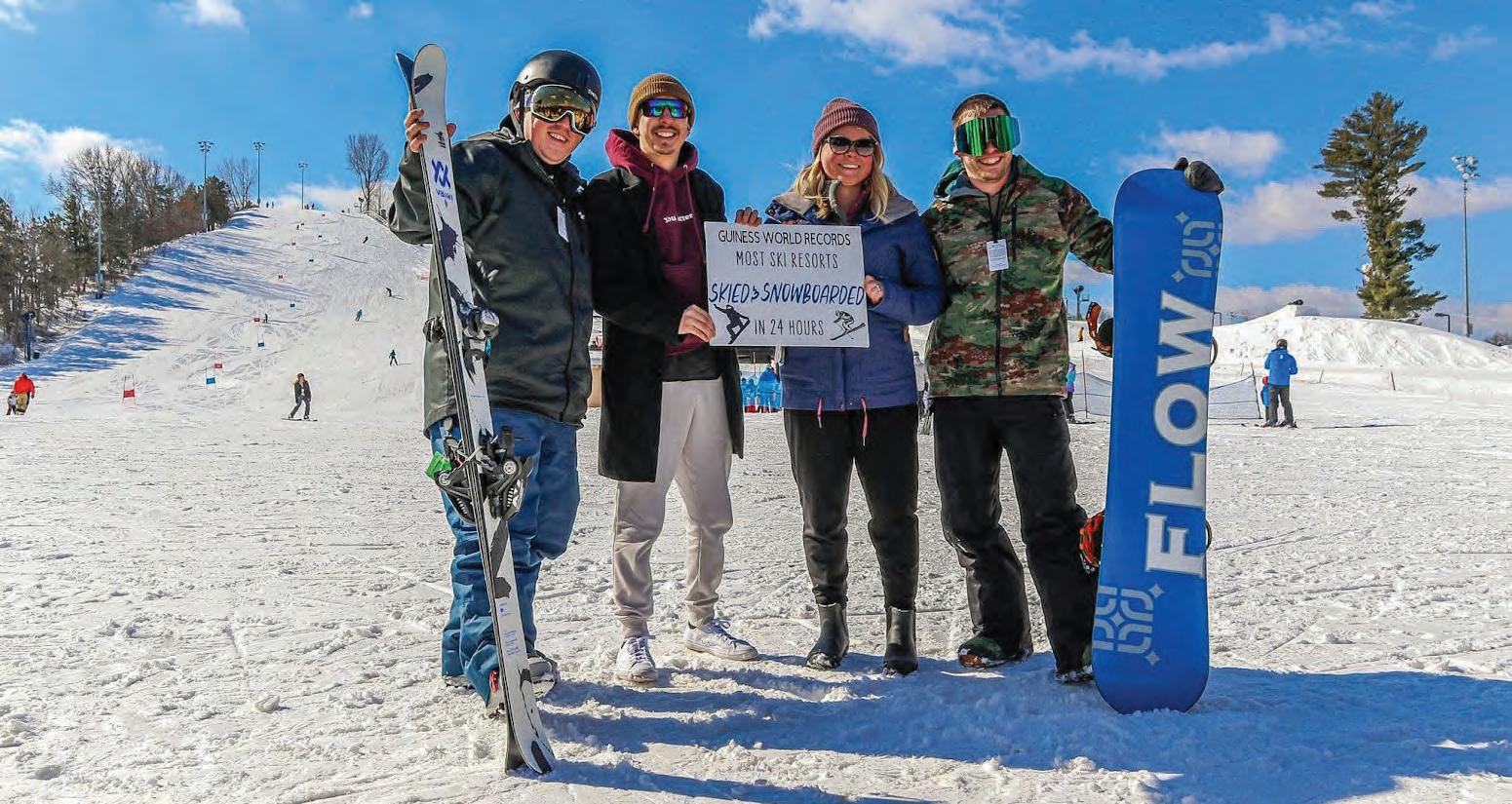
Nub’s Nob in Harbor Springs, followed by a stop at a nearby resort, The Highlands (a Boyne property).
Day one ultimately included 15 locations, from Harbor Springs to Boyne Falls, Gaylord, Grayling, Bellaire, Traverse City, Glen Arbor, Thompsonville, Cadillac (home of Caberfae Peaks, which opened in 1937 as Michigan’s first destination ski resort), and Harrison. Each run had to be independently witnessed, documented, and videographed as part of the world-record requirements.
“One of the more noteworthy stops was The Homestead,” says Kelly, who has been downhill skiing since he was about 7. “We got there right as the sun was setting over Lake Michigan. There was that ‘golden hour’ look to everything, and it was really amazing. I still get goosebumps thinking about it. It was just so beautiful. I was taken aback by that.”
Well after the sun had set (6:49 p.m.), Kelly, Dykstra (who has been snowboarding for about 8 years), and their entourage made their way to the southeast part of the state, arriving at Mt. Holly in the middle of the night.
After a couple hours of sleep for Dykstra and the crew, and 30 minutes for Kelly (who had to download all of the video footage and recharge camera batteries) in the ski patrol building, they made their way back to the slopes at 4 a.m. Eight more ski areas followed throughout the morning, including Swiss Valley in Jones. The day ended one hour ahead of the 24-hour deadline at Cannonsburg Ski Area in Belmont, near Grand Rapids, where a celebration took place.
“It was really cool that we got to ride so many different ways to the top of our runs,” says Kelly, noting that they were transported by ski lift, rope tow, inside a Sno-Cat groomer, on a snowmobile, behind a snowmobile, and on a Magic Carpet (like the flat escalator “sidewalks” inside airport terminals). “A T-bar was the only thing we didn’t get to do.”
Along the way, other skiers and boarders cheered them on and posed for selfies (which
thankfully didn’t delay their schedule). It’s this friendly, tightknit community that keeps Kelly and Dykstra active within the sport in Michigan.
“It’s all about getting out and having a good time together,” Kelly says. “People don’t realize it, but there’s just so much that Michigan has to offer for skiing and snowboarding, and winter sports in general.”
Kelly’s assessment sounds like an endorsement for the Pure Michigan (michigan. org) brand, which suits David Lorenz, vice president of Travel Michigan, just fine. “We applaud Kyle and Brad’s accomplishment of breaking the world record and we look forward to another exciting Pure Michigan winter season,” he says.
Now, nearly a year later, some might ask what’s next for the two. Perhaps 24 ski areas in 24 hours? There are definitely enough places, if the timing is right. MacWilliams notes that 29 of the state’s 39 ski areas are found in the Lower Peninsula.
“It was definitely tiresome, but well worth it. I loved finding all of the ski resorts in Michigan I’ve never heard of or been to before,” Dykstra says. Of the 23 ski areas they rode, 14 were new to both men.
this page: It was fast paced for snowboarder Brad Dykstra (left) and skier Kyle Kelly. David Lorenz of Travel Michigan (below) joined the fun. Opposite page: The support team, Dom Garcia and Lynsey Dykstra (Brad’s wife), helped to document the duo’s every run.


“We’ll never forget how much planning went into the day. In the end, it actually went off without a hitch. I’m glad I had supportive friends and a wife who made it all come together,” he adds.
Order of the resorts visited on Saturday, Feb. 26: Nub’s Nob, Harbor Springs; The Highlands, Harbor Springs; Challenge Mountain, Boyne Falls; Boyne Mountain, Boyne Falls; Treetops Resort and Otsego Resort, Gaylord; Hanson Hills, Grayling; Shanty Creek/Schuss Mountain, Bellaire; Mt. Holiday and Hickory Hills, Traverse City; The Homestead, Glen Arbor; Crystal Mountain, Thompsonville; Caberfae Peaks, Cadillac; and Snow Snake, Harrison. On Sunday, Feb. 27, the pair skied Mt. Holly, Holly; Pine Knob, Clarkston; Alpine Valley, White Lake; Mt. Brighton, Brighton; Swiss Valley, Jones; Timber Ridge, Gobles; Bittersweet, Otsego; and Cannonsburg, Belmont.

Glass chips in various sizes and colors are combined to create stunning artwork.
Birmingham’s new home shop, sofas for all, and serving good wine to protect the Great Lakes.
Learn about a talented mosaic artist from Huntington Woods.

Husband/wife architect duo renovates a Huron River home.
Cozy throws, nautical nuances, and the latest in outerwear.
Home-related tips, trends, and tidbits
COASTAL VIBES: Serena & Lily has opened a shop in Birmingham, on Maple Road. The Birmingham Design Shop will showcase the design-driven luxury home brand’s polished coastal aesthetic, which takes a relaxed yet refined approach to furniture, bedding, home accessories, and interior design. Original artwork from artists across Michigan will be displayed, including pieces by Stephanie Schlatter, Beth Billups, and Martyna Alexander. serenaandlily.com.
HAVE A SEAT: Gardner White, a top Michigan furniture and mattress store, has introduced two exclusive modular sofa collections, The Linq and The Hugg. Both provide extreme comfort and versatility for relaxing and entertaining at the cottage. Twelve stores in metro Detroit, Ann Arbor, and Saginaw. gardner-white.com.
DO-GOOD POURS: What to pour at your next gathering? Help the environment with Sustain. Some of the proceeds from the sale of this new wine from Mawby Sparkling Wine and Cherry Republic goes to the Great Lakes Business Network (an organization that helps business owners amplify their voice for Great Lakes protection). Sustain is available at Mawby (in store and online) and at Cherry Republic’s Traverse City and Glen Arbor retail locations. The wine is made up of 60 percent cherry wine and 40 percent grape wine. cherryrepublic.com, glbusinessnetwork.com, mawby.wine.
Compiled by Megan Swoyer
Have news about waterfront living? Email M egan@WaterlooGroup.com.
 By Megan Swoyer
By Megan Swoyer
Michelle Sider sees the world from a color and contour perspective, like many artists. But she also views her favorite scenes and vignettes in a unique,“chip”mode. How, she asks herself, can I create this subject I’m viewing with glass?
Sider is a mosaic artist who’s crazy about radiant glass pieces that, when arranged properly, create a stunning scene. Her artistry showcases brilliant light, golden sheens, and swaths of multilayered colors, all created with bits of glass that range in size from minuscule to large slabs.
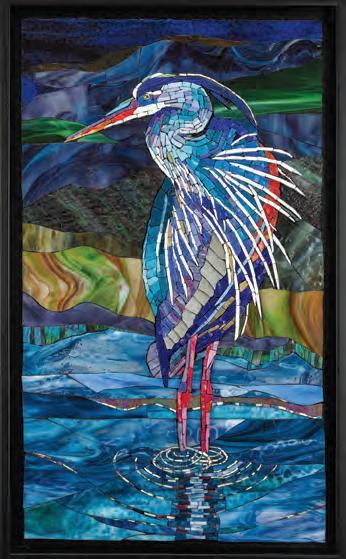
“It’s the vibrancy of mosaics that I love; the materials are exquisite,” Sider says as she moves about her natural-light-filled home studio in Huntington Woods. “I love the vision required to be a mosaic artist. I have to see how the artwork will come together. Each artwork has personality.” Individual traits show up in everything from water-rich
pieces in her heron series (which came about during the Flint water crisis) to sunset and sailboat scenes on the Great Lakes.
Sider, who received a fine arts degree from the University of Michigan and a doctorate in clinical psychology from the University of Detroit, started her professional career as a pastel and watercolor painter. Then she decided to go into art therapy and psychology, and worked with children and families. “Art is a great vehicle for helping people,” she says. Following a life-changing accident, a light went on, she says, directing her to her next path.
“One day, after the accident, I’m lying there in bed thinking about what I love. I love to create art. So I healed, and then I became a high school art teacher at Frankel Academy in West Bloomfield.” About 15 years ago she became interested in mosaics, and explains she was fascinated with the Romare Bearden mosaic work (Quilting Time) at the Detroit Institute of Arts. She also became intrigued by community mosaics. It wasn’t until she retired seven years ago that Sider decided to create mosaic art full time. “In that decade of my life, I became more confident. I also had more to say and more experiences to help express aspects of how I see the world,”she says.
Both pages, clockwise from left: “Blue Heron,”
“Sunset Sailboat,” “Mission Peninsula Looking North,” and “Preening” are a few of Michelle Sider’s works.
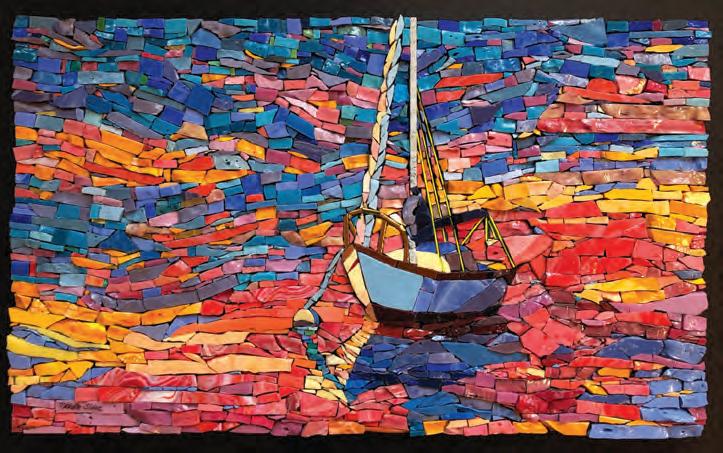
and I see how the water reflects the sun, I’m moved to create. Or when I watch sandhill cranes walk — they’re so elegant, and I love the way they move. It’s that moment that I try to capture.”
feels like a brush stroke. And I’ve got to be sure it catches the light in a certain way, so the person who looks at it has a lovely experience taking in the piece.”
Looking toward the future, Sider wants to advance the light aspects in her Michigan pieces. “For reflections, I’m using different glass, so I’m pushing myself technically. I may have mist, too. I don’t have any limits on myself,” she says.
As if she’s reflecting upon the great blue heron’s fascinating flight capabilities, she adds, “I want to soar with this stuff!”
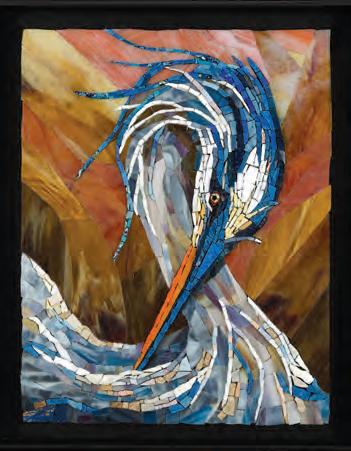
Most of the factories that make the glass Sider uses are more than 100 years old. Many are in the United States, while others are based in Italy. The tools she works with include the same style of hammers that Egyptians used, she explains. To place tiny glass bits into her work, she uses a nipper tool “for precision,” she says.“I’m a glass and nipper geek,” she adds with a laugh.
Born in Livonia and raised in Southfield, Sider has immersed herself in all things Michigan her entire life. “I’m a Michigander through and through, and am inspired by my surroundings,” she says. That inspiration is evident in her landscapes and nature series. “If I’m standing on the Lake Michigan shore
Sider’s mosaic artistry involves several steps. “First I draw a study, and then I do a painting (which she adheres to the board canvas on which the glass is glued). Next, it’s time to decide what types of glass will be needed and which colors she’ll select. If she has pieces in stock, she’ll use those, but often she needs to fill in with glass she may not have on hand.“I’m lucky to live only a one and a half-hour drive from Delphi Glass Creativity Center in Lansing. I’ll pick up stained glass there; it’s generally a domestic glass. I also like to go to Italy and watch artisans make glass. Glass-making is an art form, and they make glass 24/7. There’s even a library of glass in Venice!” Sider often packs her suitcase with Italian goods; one time she says she brought home 72 pounds of glass — all bubble-wrapped, of course.
Beyond adhering the glass to the canvas board, Sider must make constant engineering and dimensional decisions on which angle of the glass will show. She likes to lay the glass in so that it conveys the feeling of painted brushstrokes. “I’m influenced by brushstrokes. I like to see the hand of the artist, so the glass is laid in a design that often
MORE INFORMATION: Michelle Sider’s art can be viewed at michellesider.com. She also has works for sale at the Main Street Gallery in Leland and the Twisted Fish in Elk Rapids. Sider also does commissioned work.

Since college, husband-and-wife architects Brad and Theresa Angelini, of Angelini & Associates Architects in Ann Arbor, have been together every step of the way. “We met at Ohio State University, which is a bad thing to say in Ann Arbor,” Brad quips.

Upon graduation, they both headed to the University of Illinois Chicago for graduate school and received master’s degrees in architecture. After working in Chicago and on the East Coast, they each earned another master’s degree in architecture from the University of Notre Dame. The couple later taught at the University of Michigan — he taught an architectural design studio and
a graduate-level architectural theory class, while she taught an architectural design studio.
“Teaching is fun, but we really like to make things,” Brad says. He and Theresa have been in business for 35 years and have two grown children.
Their recent work includes a total remodel on the Huron River in Ann Arbor. “It was almost like a home you would see in any subdivision; a one-story with teeny windows that weren’t taking advantage of the river,” Brad says.
The clients suggested placing the main living areas along the water, with private spaces on the other side. “The river bends right near the house, and they have spectacular views,” Brad says. “To make that big of a suggestion to flip the house completely, with all the public spaces along the river, it was magic — and it triggered the ability to put glass along the whole front wall.”

Both pages, clockwise from far left: Theresa and Brad Angelini, riverfront beauty, dining area views, windows line the back of the house, and smart landscaping appointments make for fun entertaining.

A dark blue exterior reveals a hint of purple, while the deck features a spiral staircase that leads to the canoe launch without blocking the windows or the walkout basement. An adjacent patio has a fire pit, hot tub, and outdoor kitchen. “You can look at the sun setting on the river,” Brad says. “In many ways, it’s like looking at a lake.”


The project began in 2020, and “we really went through the pandemic together,” Theresa says about the unique endeavor. “(In the updated home), the kitchen, dining room, living room, golf simulator, and media room are all along the riverfront.”
“Now,” she says, “it’s really a home that’s about the river.”
A team effort between the client and designer i s the best way to pull off a fantastic project, the Angelinis say. “What really contributed to the success of this remodel was working closely with the clients, who were actively involved,” Theresa Angelini says. “They had great communication, and they were really respectful of our professional opinion. It was a collaborative process.” JM
The Huron River spans 130 miles, from O akland C ounty to Ann Arbor and Lake Erie. As a popular destination for seasonal recreation, it has plenty to offer, including kayaking, canoeing, and winter sports like cross-country skiing and ice skating. JM
1. THE ELEMENTS
Warm cover-ups will keep you cottage-cozy all winter Styled
2. 3. 4. 7. 6. 5.
1. One-of-a-kind K antha Quilts from THE HAPPY WOMAN STORE are m ade from antique Indian s aris. $65, The Happy Woman Store, Suttons Bay, thehappywomanstore. com.
2. Embrace warmth,
c omfort, and luxury with an Ivory Mink Faux Fur Throw by COUTURE COLLECTION $ 350-$425, T he Quiet Moose, Petoskey, fabulousfurs.com, quiet moose.com.

3. This ultra-plush NIKKI CHU throw
embraces the elegant and inviting craftsmanship of Danish style. Pricing upon request, Verce Design, Michigan Design Center, Troy, michigandesign.com, vercedesign.com.
4. A candy-stripe throw by RUTH
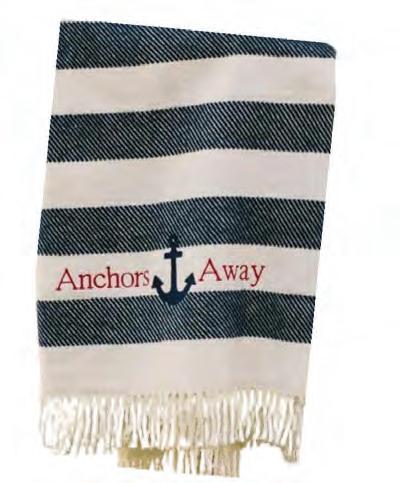
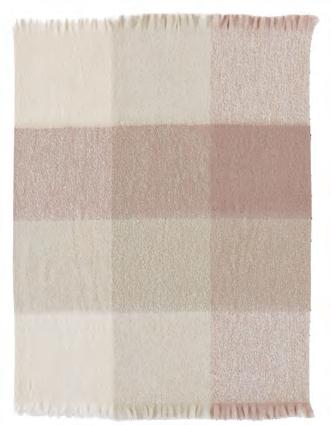
CASPER DESIGN is perfect for getting cozy. $118 (plus monogramming, optional), Ru th Casper Design Studio, Michigan Design Center, Troy, michigandesign.com, ruthcasperdesign.com.
5. The Girard Throw
by HERMAN MILLER comes in a bold black-and-white plaid. $295, Herman Miller, Grand Rapids, store. hermanmiller.com.
6. The Isak Throw by RØROS TWEED is m ade of toasty, soft lambswool in earthy tones. $215, Design

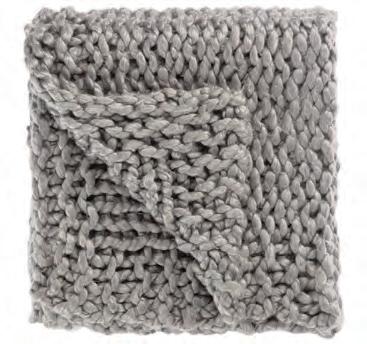
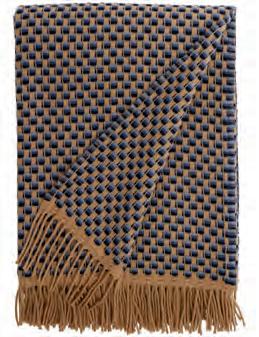
Within Reach, Grand Rapids, dwr.com.




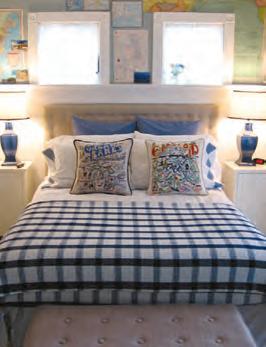
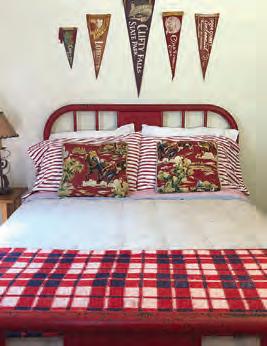
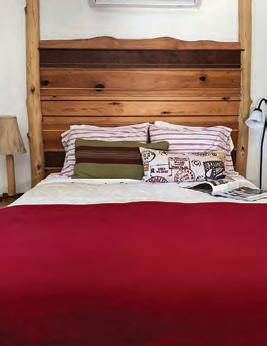
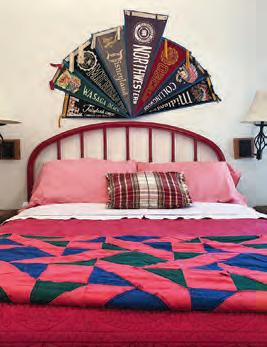
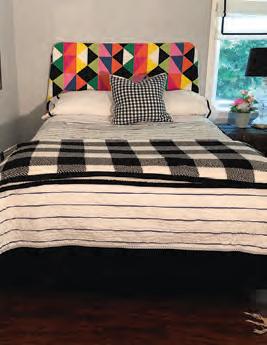


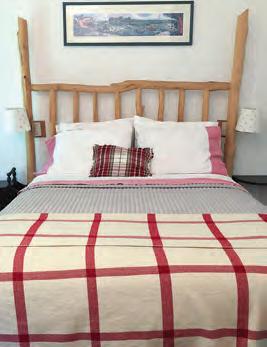


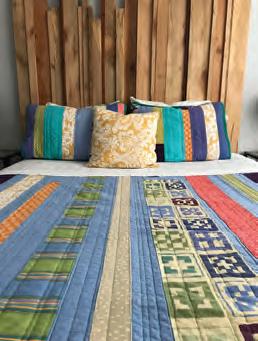
The boat lover in you is sure to appreciate these top-deck essentials for your watercraft or cottage Styled by Jamie Fabbri
1. Add a rustic touch to your boat ride with AERIN’s Freya Wicker Ice Bucket with Ice Tongs. $385, Neiman Marcus, Troy, aerin.com, neimanmarcus.com.

2. A Michigan Map Pillow from ANCHORED DESIGNS BOUTIQUE is the p erfect

boat-lover’s accent for your cottage. $40, Anchored Designs Boutique, Onekama, anchoreddesignsboutique.com.
3. Decorative paddles from ARHAUS add nautical charm. $99, Arhaus, Ann Arbor and Troy, arhaus.com.

4. Shell Sculptures by CELERIE KEMBLE FOR ARTERIORS bring attention to any tabletop. $430/set of 3, arteriorshome.com.
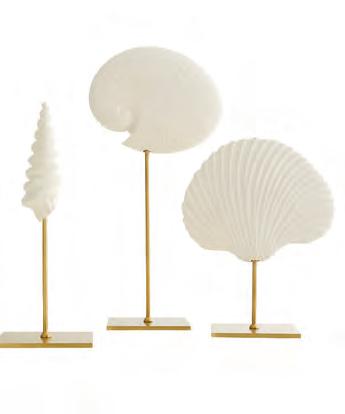
5. The Carrie Portable LED Lantern by NORM ARCHITECTS FOR MENU creates a
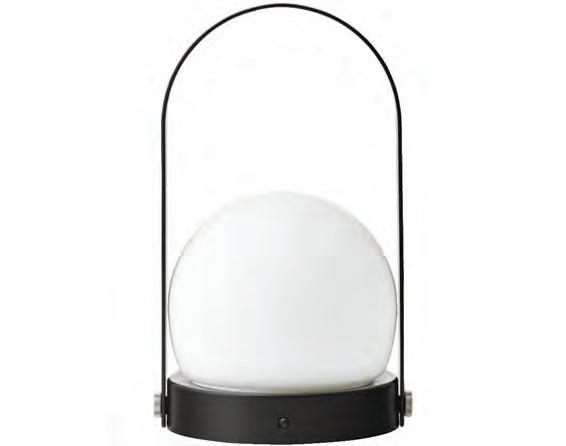
warm and toasty atmosphere w hether you’re on land or water. $250, Design Within Reach, Grand Rapids, dwr. com.
6. Freshen up summer beach days with these Check Towels by HAY $ 60 e ach, us.hay.com.

7. This vintage framed nautical photograph from FIFI & COCO is the p erfect piece of art for boat buffs. Pricing upon request, Fifi & Coco Interiors, Michigan Design Center, Troy, fifiandcoco.com, michigandesign.com.

8. The Braddock Bench by UTTERMOST adds flair with crisp navy and white stripes. Pricing upon request, Lighting Resource Studio, Michigan Design Center, Troy, michigandesign. com.


3. THE ELEMENTS
4. 5.
1. The Cashmere Travel Wrap by WHITE + WARREN is a must-have scarf that doubles as a wrap or blanket. $350, Threads, Petoskey, shopthreads.com,

whiteandwarren.com.
2. COTOPAXI’s women’s Fuego Down Vest is the perfect lightweight layer. $165, The Outpost, Manistee, outpostmanistee.com.

2. 40 MICHIGAN BLUE | W INTER 2023
3. Hand-knit mittens from THE HAPPY WOMAN STORE come in a variety of fun colors. $40-$45, The Happy Woman Store, Suttons Bay, thehappywomanstore.com.

4. A Michigan Crewneck Sweatshirt from ANCHORED DESIGNS BOUTIQUE is the p erfect layering piece. $48, Anchored Designs Boutique, Onekama, anchored-

designsboutique.com.
5. The Izalco Short Down Jacket by MONCLER is a contempor ary take on the classic men’s down jacket. $1,540, moncler.com.

6. Keep your little one warm and stylish with the Fur Beanie by VERLOOP. $58, verloopknits.com.

















































































































































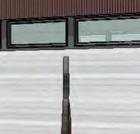
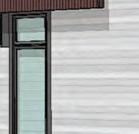






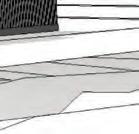

















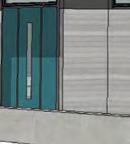
















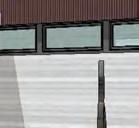


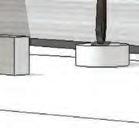
























































































Drone-Captured View of the Crooked Lake Home and Property With an abundance of windows, the home feels as though it’s one with nature, giving the Brennans a sense that they’re outdoors e ven when they’re indoors. The emphasis on consistency in design, especially with the use of stone and other materials, helps make this seamless blending possible.
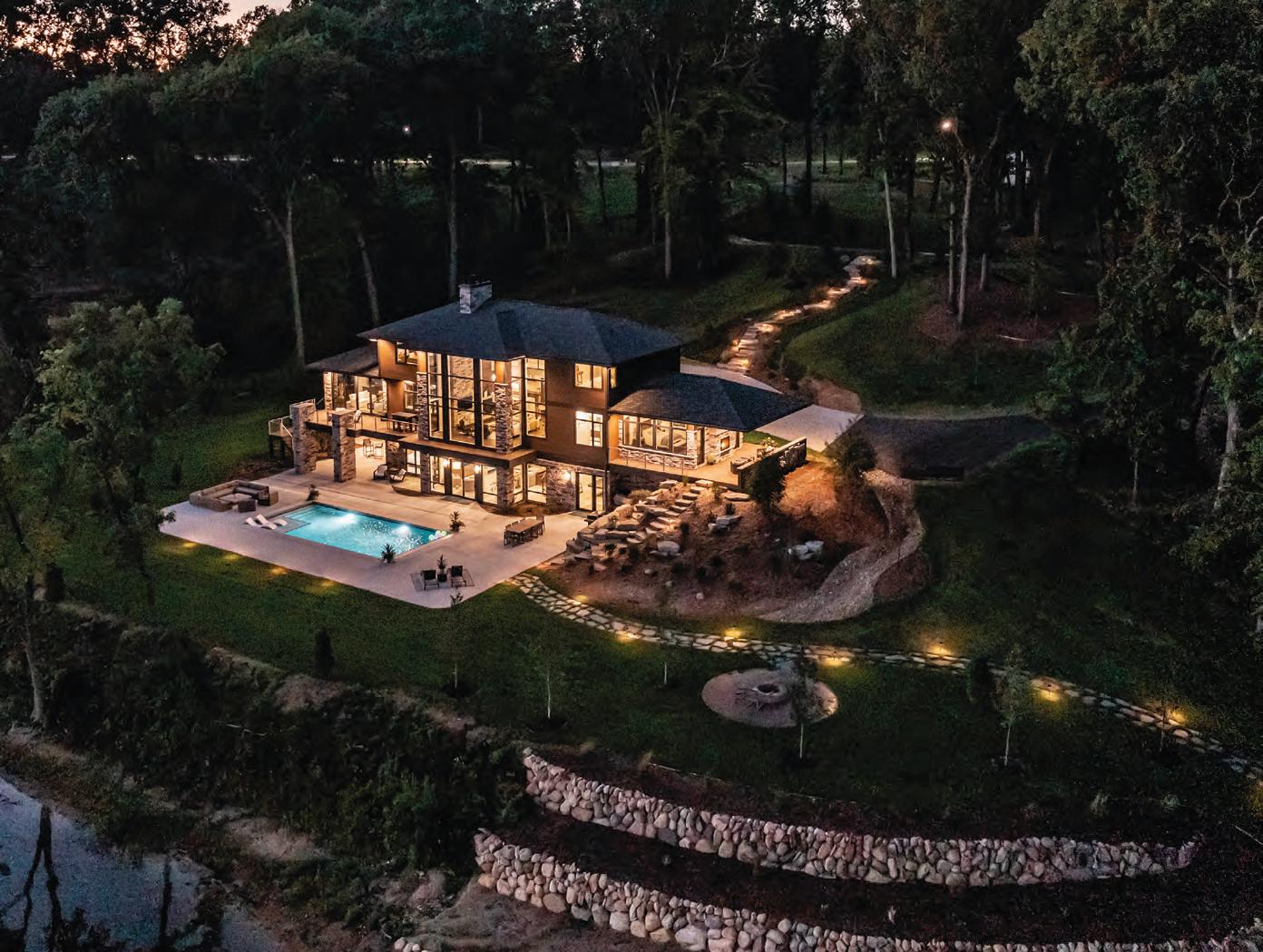
Annette and Jeff Brennan were thousands of miles from their home in Kalamazoo, Michigan when the first hints of this Great Lake Story unfolded. Celebrating 25 years of marriage, they dined, and whale watched at a picturesque, cliffside restaurant overlooking Oregon’s Depoe Bay and envisioned where their next 25-plus years would take them. When Jeff asked Annette, "When we're done working and raising children, and if you could have whatever you want, what would that be," she already knew the answer. She wanted a place; a large lake house for their children and grandchildren to visit and come home to. And, while that could have been anywhere, they ultimately decided they wanted to stay in Southwest Michigan.
In architectural design, it’s not always a given that what’s drawn on paper comes to fruition in perfect alignment with the initial vision. Intentions for the home change. Expectations for the homeowners’ lifestyle shift. For the Brennans, their aspirations for their Crooked Lake home remained a constant — and Ryan La Haie’s design followed closely throughout the process.
With construction complete, those goals have become fully realized: A lakefront retreat that draws friends in and brings family back home. A space for gathering, entertaining, and celebrating. A warm, welcoming abode from which to embark on the next phase of life. Few homes can accomplish so much — and deliver so much satisfaction — so effectively.
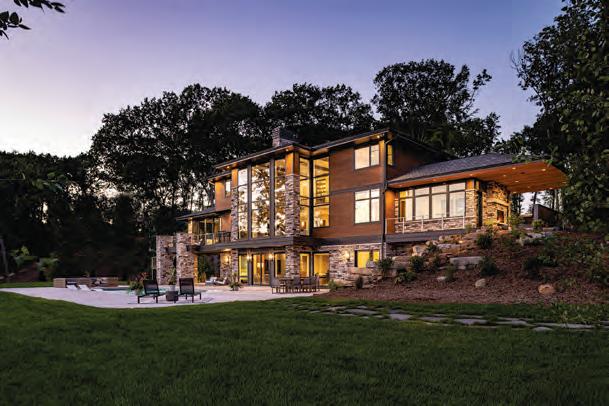
“We set out to create the perfect house for the Brennans based on their wishes to entertain and bring people together,” says La Haie, principal of 42° North – Architecture + Design. “To see it play out so true to their dreams is something special.”
Although the Brennan family knew La Haie was a master of space, it wasn’t until they moved in that they realized the beauty of the layout of the home. They say they’re using all of the rooms in the house on a regular basis because all the spaces are relaxed, open, and inviting.
“The primary goal of having this home bring our family and friends together has been achieved magnificently,” the couple says. “We’ve had multiple gatherings of 20 or more people, and one party of about 100 people, and the house worked beautifully. It never once has felt crowded, and people have felt comfortable here, enjoying each other’s company on the lake. Mission accomplished!”
This chapter closes the story of the design and construction of the Crooked Lake home. But, for the Brennans, it’s really just the beginning.

Multiple spots for gathering, including a firepit, an outdoor dining area, and other strategically placed seating areas give the Brennans and their guests ample options to commune with one another.
The Brennans enjoy stunning lake views from inside the b edroom. Having coffee on the porch outdoors, even in the rain, offers them a calming and peaceful way to start each day. A two-sided fireplace provides comfort and warmth both inside and outside of the suite.
The entire team, comprised of 42° North – Architecture + Design, Jim Roberts Construction, Cnossen Construction, Christine DiMaria Design, Kirshman Kitchen Design Studio, and TruMedia, has been honored to be involved in such a rewarding project.
 By Khristi Z immeth Photography by Beth Singer
By Khristi Z immeth Photography by Beth Singer
Residential projects from the 1970s don’t often age well.
The five-bedroom, 4.5-bath, 4,000-square-foot cottage that Alexis Elley, of Textures Interior Design in Grosse Pointe Farms, recently completed is no exception.

Built in 1979, the Harbor Springs property in the L’Arbre Croche development boasted a good layout, with outdoor access on each of the four levels and a walking path to Lake Michigan. But it also had unattractive flooring throughout, an outdated kitchen and
bathrooms, painted cedar walls, and popcorn ceilings. “Nothing had been touched since it was built,” Elley explains.
The homeowners, who live in Grosse Pointe Farms, “wanted something fresh and different,” the designer says, and were looking for a getaway that complemented the young family’s active lifestyle. “They wanted a space that caters to entertaining and family fun,” Elley says. “Having grown up spending my summers and winter ski weekends in Harbor Springs, I jumped at the opportunity.”
This page: A c ottage-style kitchen does the trick for entertaining. Opposite page: The great room lives up to its name.
A 1970s Up North cottage gets a be autiful makeover for a n active family
The fact that it was a second home also appealed to the designer. “Since this was a holiday home, I would be able to use designs that were a little out of the box,” she says.
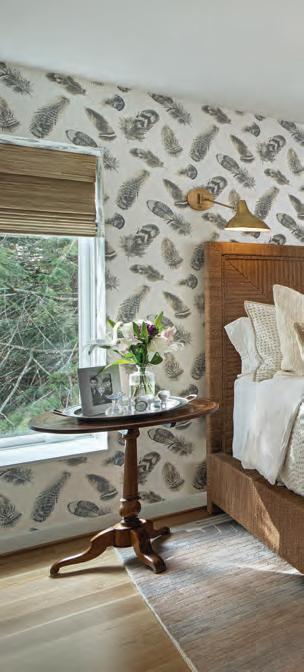


The project was “a total gut job,” although the layout remained largely the same except for the master suite, which originally had odd in-room sinks. “We had to reconfigure that, and move the sinks out of the room to make the bathroom private and functional. We also added a wall of custom built-ins in the great room for storage, as well as custom bunk beds in the bunk room.” The team updated other bathrooms and the kitchen, as well.

For the interiors, the homeowners wanted “a natural and serene environment with subtle color,” Elley explains. She describes the overall interior style she created as “rustic glam, with some transitional and modern elements. I love to use neutrals, including white and brown, with pops of black and little splashes of color.”
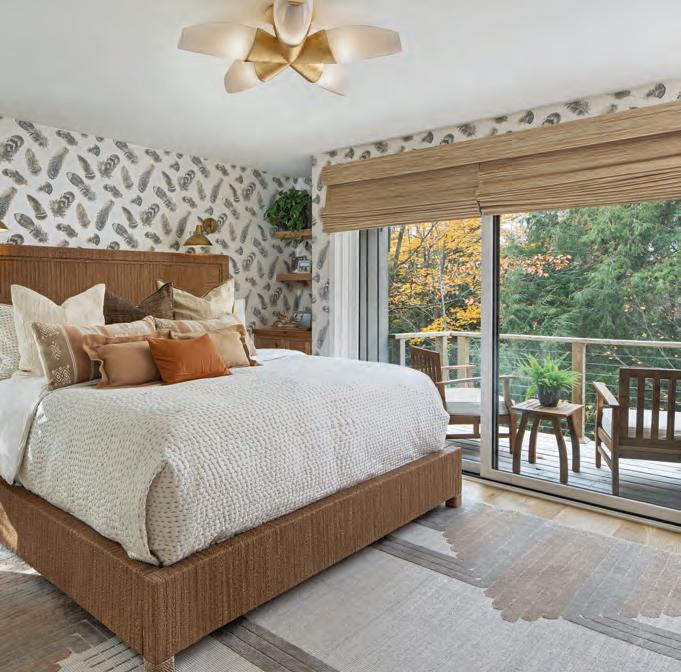

Nicknamed “The Treehouse,” the property is surrounded by woods. That led Elley to incorporate subtle greens and blues, in addition to “lots of natural textures and tones,” throughout the residence.
The expansive great room is among Elley’s favorite spaces. “We created three areas to accommodate dining, a seating area facing the fireplace for conversation, and a large sectional and ottoman facing custom built-ins for movie nights,” she shares. The original stone fireplace, which serves as the room’s focal point, was updated with a new mantel made from reclaimed white oak and a black granite hearth. Elley topped it with a three-panel art piece featuring a stag — “a different spin on the traditional taxidermy seen in so many northern Michigan homes,”she explains.
Both pages, clockwise from upper left: A feathery bedroom vignette. The cottage’s layout remained largely the same except for the master suite, which originally had in-room sinks. It’s now a beautiful oasis. Another great room perspective.
A perfect set-up for cocktail hour. The cozy dining room awaits friends and family.
Other highlights, she says, include the bunkroom “with its hunter green beds and personal reading lights for sleepovers and late-night bedtime stories,” and the powder room, with its custom scalloped white oak countertop and grass cloth leopard print wallpaper, “because every house needs a little animal print.”
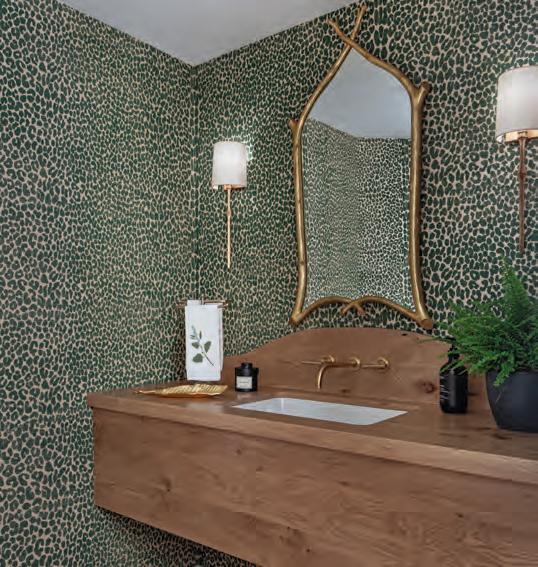

The project was Elley’s first remote undertaking. The distance between the project and her Grosse Pointe base made for an interesting project. “I like to pop in to see my projects every day,” she says. Although this project prohibited her from checking in daily, she went up to Harbor Springs at least once a month, she says, and she and the homeowner spent a working weekend up north as well as days at the Michigan Design Center downstate. Elley says she had a great working relationship with contractor Steve Jakeway. “We were all on the same page,” she says. “He called me every day.”
Both pages, clockwise from above: The bunk room is a fun space for kids of all ages. The cozy lounge features kid-friendly cube seating. This guest bedroom blends bright and pale pinks with neutral tones. A bathroon with an animal print-themed wallcovering suits the getaway well, while a custom designed wood vanity adds woodsy appeal.
“(FOR THE INTERIORS, THE HOMEOWNERS WANTED) A NATURAL AND SERENE ENVIRONMENT WITH SUBTLE COLOR.”
ALEXIS ELLEY
Other than that, “it was pretty seamless,” she says, adding that she starts work soon on the family’s main residence. This undertaking may have been her first remote project, but she hopes it won’t be her last. “I would absolutely do more projects up north,” she says.

The homeowners, who moved in just in time to enjoy the 2021 summer season, agree that the project went smoothly. “We couldn’t be happier with the end result,” they assert, adding that they consider The Treehouse their “happy place.”

“We come up as often as possible,” the couple says. “Alexis brought our very basic vision to life, and then some.”

Alexis Elley, Textures Interior Design, Grosse Pointe Farms, texturesinteriordesign.com
Cabinetry – Preston Feather Building Center, Petoskey

Countertop – Envi, Quartz Lighting – Visual Comfort, City Lights Detroit, Troy Plumbing Fixtures – Kohler

Artwork, Original – Andrea Nadeau
Bed Frame and Bedding – Serena & Lily
Blanket, Throw – UGG Chair, Desk – HomeGoods
Dresser – Serena & Lily
Flooring – White Oak Light, Ceiling – Visual Comfort Light, Wall – Visual Comfort Rug – overstock.com
Shelf, Floating – White Oak Table, Bedside – Serena & Lily Wall Paint – Benjamin Moore, Simply White
Bedding – Palecek, CAI Designs, Michigan Design Center, Troy
Chairs, Patio – Teak
Dresser – Serena & Lily
Flooring – White Oak Lamp, Table – Tahari
Light, Ceiling – Kelly Wrestler, Visual Comfort Mirror – CB2
Rug – Lulu and Georgia
Sconces – Visual Comfort
Shelves, Floating – White Oak
Table, End – Antique, Joie de Vie, Petoskey Table, End (Patio) – Teak
Wallpaper – Thibaut
Window Treatment – Natural Woven Raffia
Beds, Paint – Benjamin Moore, Hunter Green Bedding – Pottery Barn and Pendleton
Artwork – Palecek
Chairs – Four Hands
Rugs – Cow Hides
Sconces – Aerin, City Lights Detroit, Michigan Design Center, Troy
Table – Four Hands
Armchairs – Four Hands
Ar twork – Trowbridge
Built-ins – Custom
Cabinetry, Mini-Bar – Preston Feathers
Chaise Lounge – Bernhardt Chandelier – Ralph Lauren, City Lights Detroit, Michigan Design Center, Troy
Countertop, Mini-Bar – Quartz (Envi)

Fireplace – Black Granite
Flooring – Wide Plank White Oak
Glassware – Riedel
Mirror – Lexington Ottoman – Article
Sconces – Ralph Lauren, City Lights Detroit, Michigan Design Center, Troy
Sectional – Vanguard Furniture, CAI Designs, Michigan Design Center, Troy
Sofa – Lee Jofa, Kravet | Lee Jofa | Brunschwig & Fils, Michigan Design Center, Troy
Stools, Cow Skin – Made Goods
Table, Coffee – Made Goods
Wall Paint – Benjamin Moore, Simply White
Backsplash and Countertop – Quartz (Envi)
Cabinetry – Preston Feathers
Flooring – White Oak
Lighting, Island – Visual Comfort, City Lights Detroit, Michigan Design Center, Troy Ovens, Double – Thermador
Refrigerator – Sub-Zero Shelves, Floating – White Oak Sink, Farmhouse – Kohler

Wall Paint – Benjamin Moore, Simply White
Armchairs – Four Hands Ar t, Native American – Lauren Kirchner Photography Cabinets – Wood Harbor, Preston Feathers
Flooring – Wide Plank White Oak Mug – Majollica
Ottoman, Cube – HomeGoods Pillows, Accent – South African Spring Buck Pelts, Vanguard Furniture Plates – Juliska Rug – Four Hands
Shelves, Floating – White Oak Sofa – Sleeper Sofa, Vanguard Furniture Table, Coffee – Four Hands Tables, Geometric – HomeGoods Wall Paint – Benjamin Moore, Simply White
POWDEr rOOM
Faucet – Brizo Mirror – Carvers’ Guild
Sconces – Visual Comfort, City Lights Detroit, Michigan Design Center, Troy Wallpaper – Lee Jofa, Kravet | Lee Jofa | Brunschwig & Fils, Michigan Design Center, Troy
Chandelier – Visual Comfort, City Lights Detroit, Michigan Design Center, Troy
Flooring – White Oak
Stairs and Railing – Plexiglass and White Oak Wall Paint – Benjamin Moore, Simply White
Builder – Steve Jakeway, Steve Jakeway Builders, Petoskey
Cabinetry – Paula Keipert, Preston Feather Building Center, Petoskey
By definition, a cabin evokes a cozy home in a remote location. “It’s a reflection of its setting and it can be even more casual than a cottage,” Rob Mossburg, a third-generation builder and owner of The Cottage Company of Harbor Springs, says. “A cabin can also be more rustic or primitive, and have more earth tones and natural colors — like greens and browns — instead of the blues and whites found in a cottage.”

One such structure, affectionately named “Josie’s Cabin”for his mom, was a family affair
this page: The Mossburg cabin looks enchanting come nightfall, especially in winter. Opposite page: Open spaces and comfortable furnishings are the name of the game at the family haven. A unique mix of logs and light finishes puts the accent on bright.
from conception to completion, and beyond. “The home was designed on the cozy side, but it wasn’t meant to be a full-blown log cabin with darker tones,” Mossburg says about the custom dwelling built for his parents in Harbor Springs near the Tunnel of Trees, a popular scenic route. “ Given the year-round usage, it’s a more contemporary mix of logs and light finishes on the interior, (as well as) the exterior accents.”
Many furnishings came to the quaint cabin from his parents’ former home, including

family heirlooms like an old writing desk. “It’s a sensible scale, perfect for two people with occasional visitors,” he says. “It just worked really well for them.”
Rob and his wife, Vee, owner of Cottage Company Interiors, purchased the 100-acre property that sits across from Lake Michigan before The Cottage Company built the cabin. “We really enjoy spending time together, even when we’re working,” Mossburg says about the family. His sister, Jill Nuding, was the project manager and her husband, Greg,
a master carpenter, contributed to the home along with their dad, Bob Jr., who did a lot of work by hand.
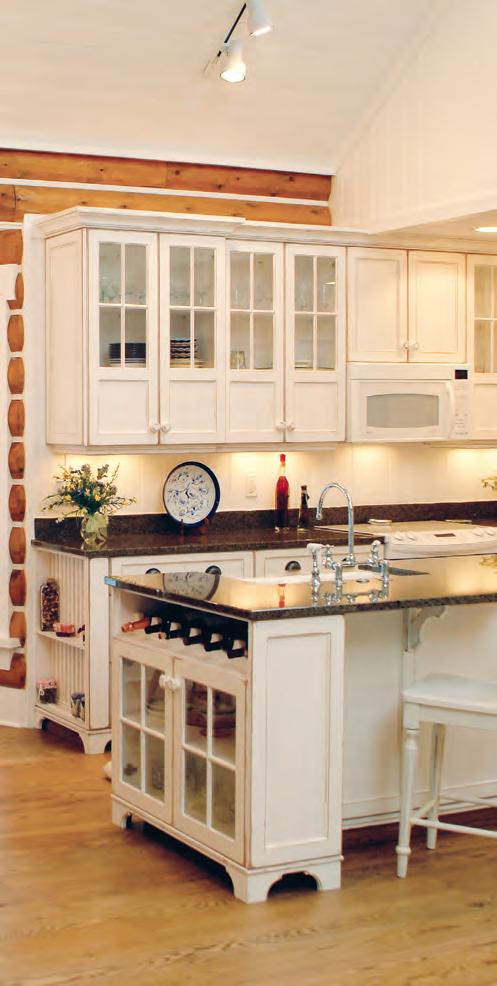
Kelly Konoske, president and owner of Cottage Company Interiors, and Rob and Vee’s daughter, says, “Originally, my parents and grandparents built log cabins in the Lewiston area before they made the transition to Harbor Springs and cottages. Grandpa still wanted a log cabin.”
Her grandparents, who have since moved, have been married since they were teens.

“A cabin can also be more rustic or primitive, and have more earth tones and natural colors ... ”
rob mossburg
this page: A canopystyle bed and a pretty Stark rug in the upstairs bedroom deliver instant charm. Opposite page: The kitchen and dining area are the perfect size for intimate gatherings. Plenty of cabinet storage comes in handy.

“They’re the perfect couple. She’s the family matriarch and he’s the patriarch. They’re simple people who love family and food,” Konoske says.
The cozy cabin that served as their primary home before it was sold blends half-log siding with beadboard ceilings. “It just goes to show you can mix design styles,” she adds.
Konoske cherishes the Christmas celebrations the family shared at the cabin. “(My grandmother) would cook for all of us, and the decorations were out. She had name
tags, and even the dog would be dressed up,” she recalls. “We would have brunch, then open presents, and we would all find a bed and sleep off the meal or play games.”
The lower level was a favorite spot for Konoske. “It had traditional red, black, and white plaid with green furniture, and wood beds with tons of blankets and really heavy duvets. I loved the weight of them,” she recalls.
For Mossburg, outdoor activities like hiking in the woods come to mind. “The cabin is

nature-oriented,” he says. “We hunted on the property and went fishing across the street. There would be a roaring fire for family dinners. It was very quintessential.”
He also remembers picking morels to incorporate into meals, and his mom’s savory baked goods made with Michigan apples and blueberries. “You could count on that seasonally, and my dad is a big fisherman, so it wasn’t uncommon to have frozen or fresh salmon or lake trout on the table from right across the driveway. The whole forestto-fork, we were really living it.”
this page: Two more perspectives of the upstairs bedroom. Antique and vintage furnishings lend themselves to the cabin vibe. Opposite page: The snow-capped cabin has everything one needs for a warm and safe winter, including plenty of firewood.

Although the cabin is no longer in the family, they left their mark with a conservation easement that protects the property from further development. Mossburg fondly recalls an anonymous letter left in the mailbox one day. “There was a handwritten note that said something like: ‘Thank you for your amazing donation to the beauty of northern Michigan from folks who will forever enjoy the Tunnel of Trees.’ ”

Cottage Company of Harbor Springs and Cottage Company Interiors, Harbor Springs, cottage-company.com

Bed Frame, Canopy – Wesley Allen
Bedding – Custom, Sarah Tippett Custom Sewing, Harbor Springs
Dresser – Lexington Furniture
Flooring – Hardwood, Ronald Brown Flooring, Cross Village Township
Light, Ceiling – All-Phase Electric, Petoskey
Rug – Stark Carpet, Pumco Interiors, Harbor Springs
Wall Paint – Benjamin Moore, White Dove
Armchairs – Hickory Chair
Bar Stools – Reid Furniture Co., Petoskey
Cabinetry – North Country Cabinets, Harbor Springs
Chandelier – Lady B Goode
Countertop – Capital Granite, Inc., Petoskey
Flooring – Hardwood, Ronald Brown Flooring, Cross Village Township Table, End – Lexington Furniture
Building Materials – Preston Feather Building Center, Harbor Springs
Landscaping – Litzenburger Landscaping, Harbor Springs
Masonry – Gino Longo Masonry, Boyne City
Architecture – Sears Architects, Grand Rapids
Painter – Snow Country Decorating, Harbor Springs


Iwas never a house painter until I was. And then, it happened only after running short on other ideas.


After 10 years of teaching and summer breaks that meant returning to Mackinac Island and holding down one or another seasonal jobs, I’d grown weary of restaurants and I proved to be unsuited to retail. So I approached my father-in-law
about painting his house. Three houses, to be more precise.
Each summer, I moved with my kids and my wife into the house where her greatgreat grandmother, Catherine Benjamin, had settled in the 1880s with her son, Robert Henry, and his wife, Hulda. My inlaws lived across the yard in a house my father-in-law bought in 1950, and next door to him was the house where he was
Both pages: Bob B enjamin was born in this house, first owned by his parents, in 1923. The yellow house on the right became the final home to make up the family compound. t
born, which had been his parents’ home and then became his sister’s house, and eventually was used as a rental.
Each house needed painting every summer and, feeling unmoored after one more seasonal transition, I reasoned I was better suited for climbing a ladder than pouring beers or selling T-shirts. Somewhat to my surprise, my father-in-law agreed.

My father-in-law, Robert Edward — Bob was also a schoolteacher and a shopkeep. He and his sister, Dorothy, an artist and journalist, had inherited their parents’ house. Their father, Herbert, had taken over
his father’s blacksmith shop in the early part of the 20th century, and kept the fire going until the 1960s.
In time, Robert Henry and Hulda grew old and died, and so did Herbert and his wife, Mary. Dorothy never grew old, but after her death Bob owned all three houses, along with the maintenance that followed. Painting was a constant and, for years, I’d watched others prep and cover one of the houses each summer. I envied their solitude and their labor. To be sure, each house regularly needed more than paint, but my skill set was limited to painting —
Both pages: The clapboard yellow house sports a new coat of Calla Lily (Benjamin Moore) paint. Glen Young reminisces while giving the trim a refresh.



Both pages: Underneath the Leisure Green (Benjamin Moore) paint on the lap siding is a log cabin frame building. Glen Young paints trim for old times’ sake. A Straits of Mackinac view.
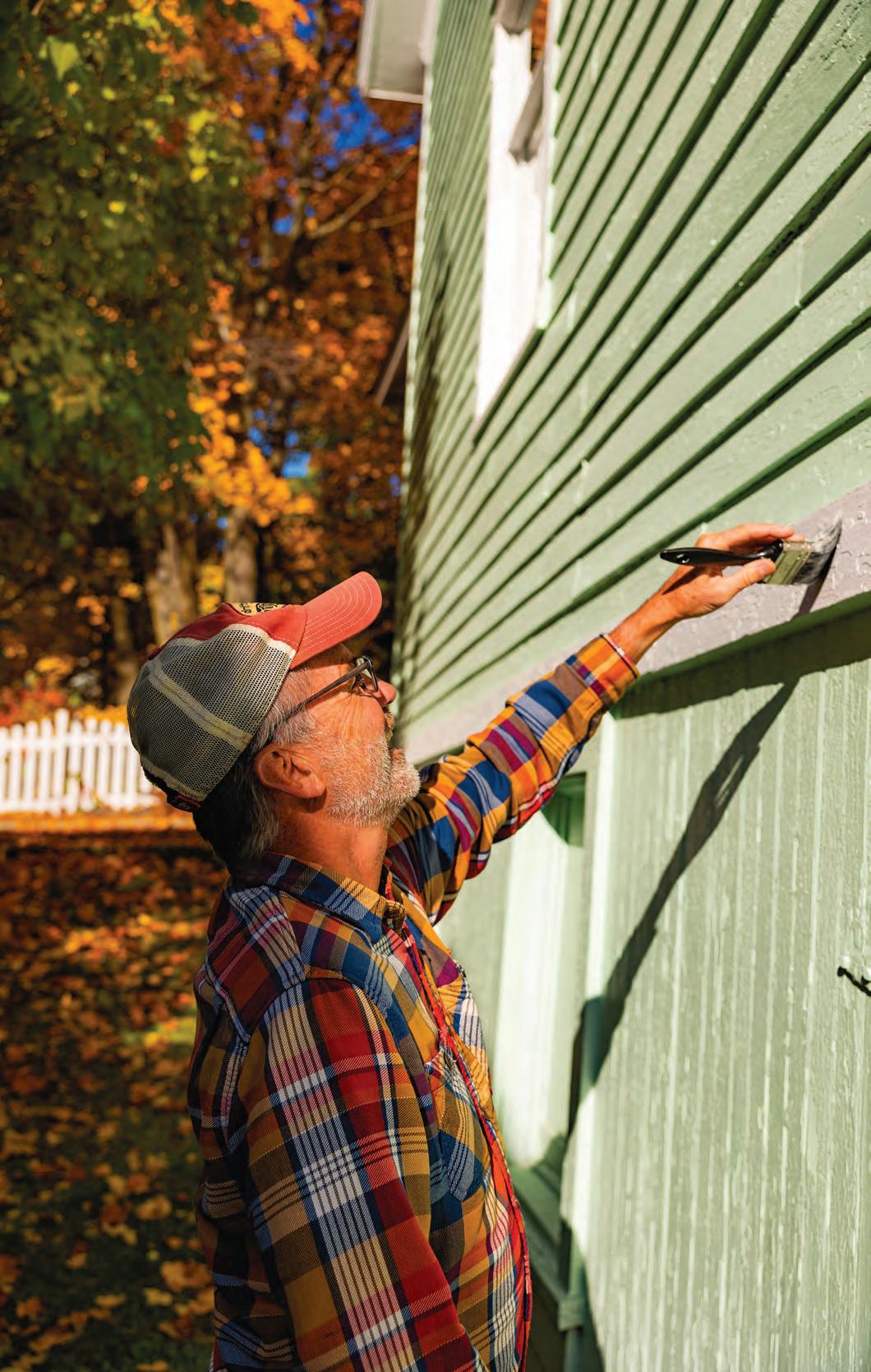
or touching up, really, as the colors seemed to peel faster than my brush could move. Nonetheless, for nearly 15 years, from June to September, I hauled my scraper or my buckets and brushes up a ladder, reveling in the quiet and the repetition.
On the busiest of days I could escape to the quiet of the roof or a far wall, camouflaged under maple leaves, but always next to this history. I soaked it in like the wood absorbed the paint.
In June, the lawn crowded with grackles, I might paint Bob’s house. By August, noisy with geese, I might move on to paint the house where I lived — the house in which Robert Henry resided when he built the Hotel Iroquois, and launched his campaign for sheriff. During the time Hulda lived there, in 1904, she helped establish the island’s Little Stone Church.


Home to five generations of Benjamins, this boardwalk cottage painted in Benjamiin Moore’s Windmill Wings and Summer Blue, looks out to views of Round Island and the Mackinac Bridge.

I often leaned my ladder against the house Bob bought in 1950, the year he opened the downtown gift shop that still bears his name. It was the house where he brought his new bride, Beverly, after their 1953 wedding, and where he wrote his three books on Mackinac history; it was the house where he and my mother-in-law raised their three children, including my wife, Jane.
My wife and I still return to the same house each summer, although our children aren’t around as much as they once were,
and Bob is gone. These days I only paint the Little Free Library near the sidewalk, where the blacksmith’s shop once stood — but those years on the ladder are, like the family history, never far away.
Glen Young, retired from house painting, now spends summers guiding kayak tours. He divides his time between Mackinac Island and Petoskey. He’s also a ski instructor, educator, editor, freelance writer, and poet.
BASED UPON A SURVEY OF THEIR PEERS
These LEADING LAWYERS have been recommended by their peers to be among the TOP LAWYERS in Michigan.
Donald F. Carney Jr. Berry Moorman PC
Birmingham 248.645.9680 Trust/Will/Estate
Harvey B. Wallace II Berry Moorman PC Detroit 313.496.1200 Trust/Will/Estate
W. Jerry Byrd Dean & Fulkerson PC
Troy 248.362.1300 Trust/Will/Estate
Roy A. Luttmann Frasco Caponigro Wineman & Scheible PLLC Troy 248.334.6767 Trust/Will/Estate

Howard H. Collens Galloway and Collens PLLC Huntington Woods 248.545.2500 Elder; Trust/Will/Estate
Peter J. Bill
Robert A. Bryant
Giarmarco Mullins & Horton PC
Troy 248.457.7201 Trust/Will/Estate
Giarmarco Mullins & Horton PC Troy 248.457.7215 Trust/Will/Estate
Thomas P. Cavanaugh Giarmarco Mullins & Horton PC Troy 248.457.7218 Trust/Will/Estate
Kara S. Ferrara
Giarmarco Mullins & Horton PC Troy 248.457.7136 Trust/Will/Estate
Julius H. Giarmarco Giarmarco Mullins & Horton PC Troy 248.457.7200 Tax: Individual; Trust/Will/Estate Salvatore J. LaMendola Giarmarco Mullins & Horton PC Troy 248.457.7204 Trust/Will/Estate
John M. Pollock Howard & Howard Attorneys PLLC Royal Oak 248.723.0388 Trust/Will/Estate



Shirley A. Kaigler
Jaffe Raitt Heuer & Weiss PC Southfield 248.727.1412 Elder; Trust/Will/Estate
James F. Anderton V Loomis Ewert Parsley Davis & Gotting PC Lansing 517.482.2400 Tax: Individual; Trust/Will/Estate
Robert D. Kaplow
Charles M. Lax
Michael W. Maddin
Richard F. Roth
William E. Sigler
Geoffrey N. Taylor
Arthur L. Malisow
Maddin Hauser Roth & Heller PC Southfield 248.827.1868 Tax: Individual; Trust/Will/Estate
Maddin Hauser Roth & Heller PC Southfield 248.827.1877 Trust/Will/Estate
Maddin Hauser Roth & Heller PC Southfield 248.827.1880 Trust/Will/Estate
Maddin Hauser Roth & Heller PC Southfield 248.827.1895 Trust/Will/Estate
Maddin Hauser Roth & Heller PC Southfield 248.827.1865 Tax: Individual; Trust/Will/Estate




Maddin Hauser Roth & Heller PC Southfield 248.827.1871 Trust/Will/Estate
Mall Malisow & Cooney PC
Sanford J. Mall Mall Malisow & Cooney PC
Harley D. Manela
Robert D. Mannor
Mall Malisow & Cooney PC
Mannor Law Group PLLC
Farmington Hills 248.538.1800 Elder; Trust/Will/Estate
Farmington Hills 248.538.1800 Elder; Trust/Will/Estate
Farmington Hills 248.538.1800 Elder; Trust/Will/Estate
Grand Blanc 810.694.9000 Trust/Will/Estate; Elder
Robert L. DeJong Miller Canfield Grand Rapids 616.776.6308 Trust/Will/Estate




John G. Van Slambrouck Miller Canfield Kalamazoo 269.383.5829 Trust/Will/Estate
Anthea E. Papista Papista & Papista PLC Detroit 313.965.1688 Trust/Will/Estate
A lawyer CANNOT buy the distinction of Leading Lawyer. The distinction was earned by being among those lawyers most often recommended by their peers. For a full description of our research process, a complete list of all Leading Lawyers, and to view profiles of the lawyers listed on this page, go to www.LeadingLawyers.com
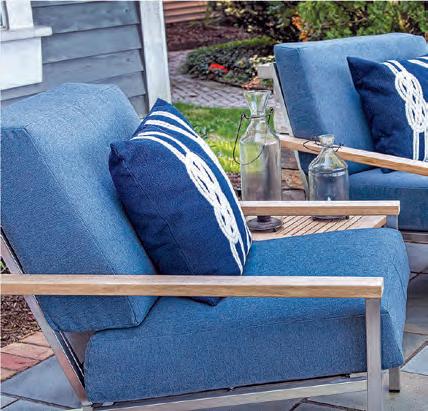











WWhen you’re in the depth of winter, there’s nothing that’s more rewarding than planning a future escape — whether it’s a few weeks away or a few months down the road. Our Great Lakes State continues to offer some of the most appealing destinations to visit, and they also keep you close to home so you can make the most of your time and your budget. From the West Michigan lakeshore to destinations farther Up North, there’s so much to see and do.
Round up the kids and take a family vacation filled with outdoor adventures ranging from amusement parks to recreation for every season. Grab your girlfriends for a weekend at a waterfront resort complete with delicious dining, poolside relaxation, and even a little yoga to refresh the spirit. Or, enjoy arts and culture, winter sports, wine tasting, and historic tours with the one you love.
The getaways featured in this section offer all of this and more. As you start putting together ideas for your next trip, look to these popular spots for itinerary inspiration.















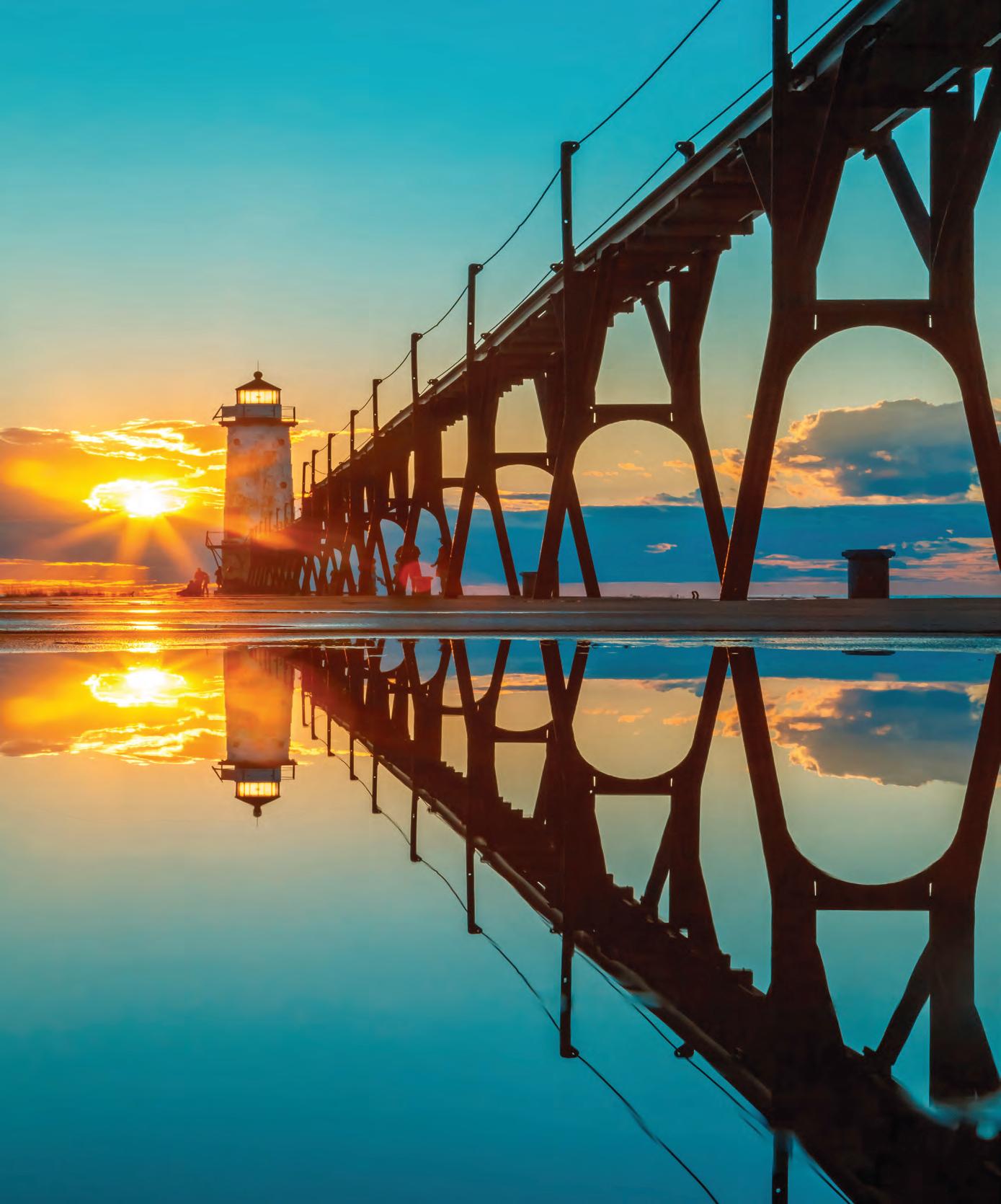
IIf you’ve always thought of northern Michigan’s Charlevoix as a summer destination, you’ve been missing out on so many things that this charming small town has to offer! Winter can be one of the most beautiful times of year in the region, and this friendly and thriving community does anything but close down.
Year round, there’s an abundance of things to do and see, from fun special events to outdoor activities, tours of historic sites, and more — plus, you’ll enjoy inspired dining and craft drinks at area wineries and breweries.

Enjoy a weekend full of recreation including skiing, snow-shoeing, exploring trails, or learning how to fat-tire bike. There are opportunities to take in weekly
candlelight hikes at Mount McSauba through February, and you can delight in winter rafting down the Jordan River, as well. Visitors will also appreciate the less expensive room rates compared to area resorts — yet you’ll still be within close proximity to all of the major ski hills.
In addition to offering candlelight hikes, Mount McSauba — a city-owned ski hill — is an affordable place where kids and adults alike can learn how to downhill ski. The facility includes a sledding hill, an ice skating rink, and cross-country trails, too.
Charlevoix is also home to the Earl Young Mushroom Houses, and a selfguided tour of these architectural treasures is a favorite visitor activity. More “musts” are located within the Charlevoix Cultural
Corridor, which is directly adjacent to downtown: the public library, the historical society, and the Charlevoix Circle of Arts are all in this neighborhood. Lovers of art, literature, music, and history will feel right at home! A guided or self-guided tour of iconic Castle Farms is also in order, as is wine tasting in its 1918 Cellars.
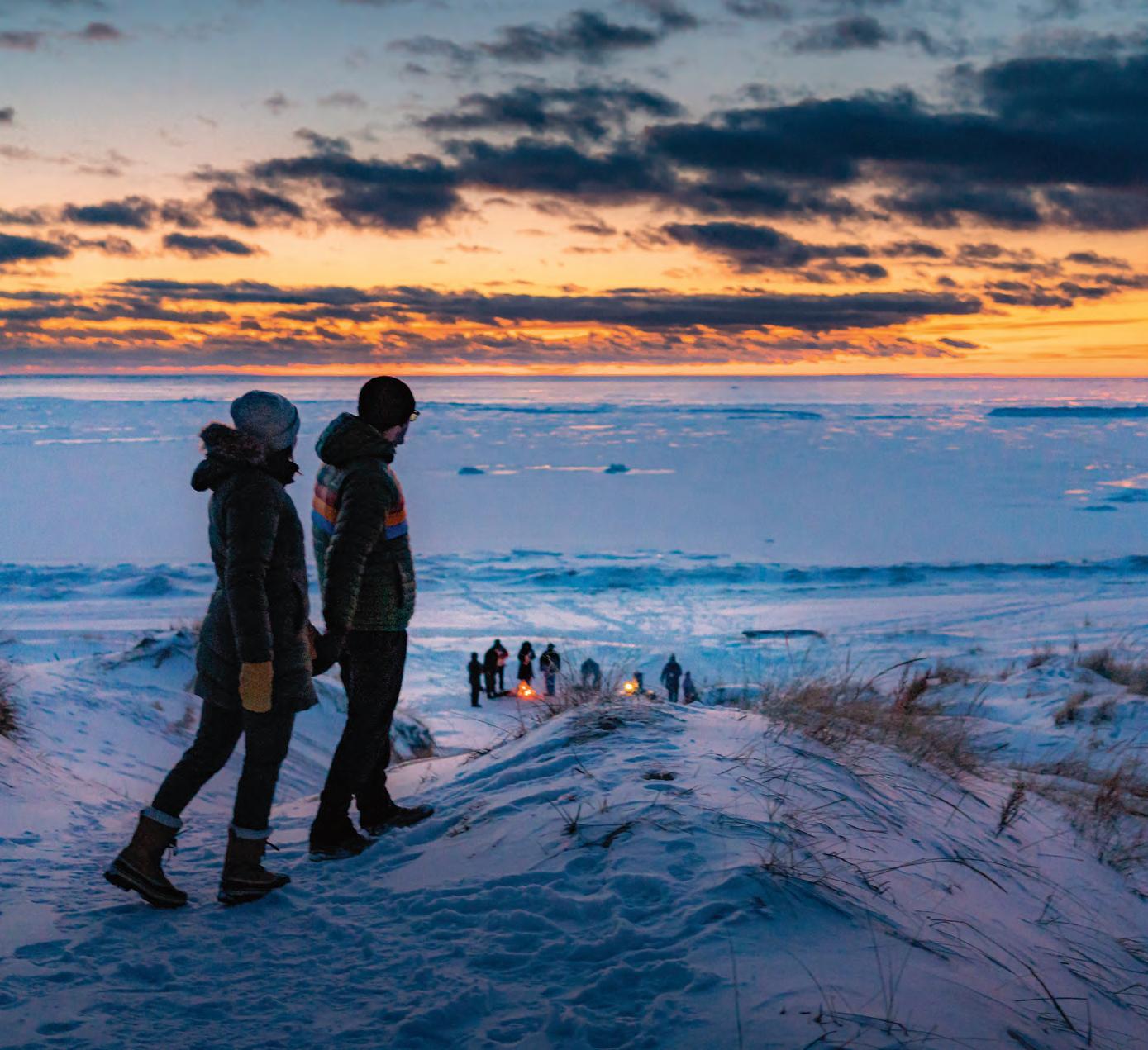


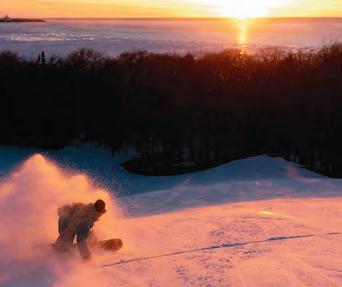












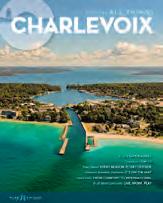

DDelamar Traverse CiTy offers guesTs a boutique, high-touch experience, making it Traverse City’s premier all-season waterfront resort. The space features contemporary accommodations, indulging amenities, impeccable service, and Artisan — an award-winning, on-site restaurant and bar featuring live music four days a week.

With its breathtaking views of Grand Traverse Bay, Delamar is the ideal destination for a romantic getaway, weekend retreat, or family vacation. The hotel offers a variety of private venues for corporate meetings, weddings, and special events. Guests enjoy indoor and outdoor heated pools year-round, wellness classes in the new Yen Yoga Fitness studio, basking on the sandy beachfront, relaxing by a roaring fire pit, and walking the short distance to bustling Front Street with its
retail shops and cafés. Seasonally, guests can book a cruise on the Wind Dancer Tallship or Nauti-Cat, both of which set sail from Delamar’s dock several times each day.
For both fine dining and a casual bite, stop in at Artisan Waterfront Restaurant & Tavern, with its elegantly appointed dining room and cozy tavern. Its sprawling outdoor patio with a bar offers splendid views of West Bay and is the perfect spot for al fresco dining and socializing during warmer weather. Artisan’s menu celebrates craftsmanship and sustainability, and features farm-fresh Great Lakes-inspired cuisine, artfully prepared by Executive Chef Frederic Kieffer. Having a celebration or special gathering of friends, family, or colleagues? Reserve Artisan’s glassed-in Birch Room for your private event.
Quickly making a name for itself for its distinctive charm and unparalleled service, Delamar takes care of every detail from the moment you arrive, offering complimentary valet parking, a glass of bubbly upon check-in, and locally made granola in your room. Ask the dedicated concierge about curated seasonal packages and experiences; they’ll gladly assist you in customizing your Delamar getaway.
Delamar Traverse City 615 East Front Street Traverse City, MI 49686 231-947-3700 delamar.com

Muskegon is a destination that’s rich in history, culture, and adventure. As the c ity has continued to grow as a tourism destination, the community has excelled in supporting and developing attractions and experiences for people of all ages, all year long.
In addition to outstanding attractions, Muskegon County has an abundance of outdoor recreation with many miles of trails and Lake Michigan beachfront, as well as close proximity to the sights and sounds of nature. Active travelers have options for biking, paddle sports, dune hiking, and so much more.
Muskegon also has one of only four publicly accessible luge tracks in America. At the Muskegon Luge Adventure Sports Park, there’s an activity
Mfor every season — including luging, ziplining, archery, rock-climbing, ice skating, cross-country skiing, and snow-shoeing.

At Michigan’s Adventure, visitors can enjoy two parks for the price of one: Michigan’s Adventure and Wildwater Adventure. The amusement park recently added a brand-new Camp Snoopy area, featuring plenty of adventures for thrillseeking guests. In 2023, Michigan’s Adventure’s first Trick and Treats Fall Festival, with an immersive trick-ortreat discovery experience, will take place Saturdays and Sundays from Sept. 16 through Oct. 15. In addition to traditional fall festivities such as seasonal crafts and themed games, families will be able to hunt for and decorate their prize pumpkin in a way that can only be done
at Michigan’s Adventure.
Meanwhile, the Muskegon Museum of Art will soon be one of the only museums in the world to have a space devoted solely to the work of women artists. As part of a 26,000-square-foot expansion, more than 150 works of art will be displayed, all painted by women in the figurative realist style. This expansion is expected to open in 2024.
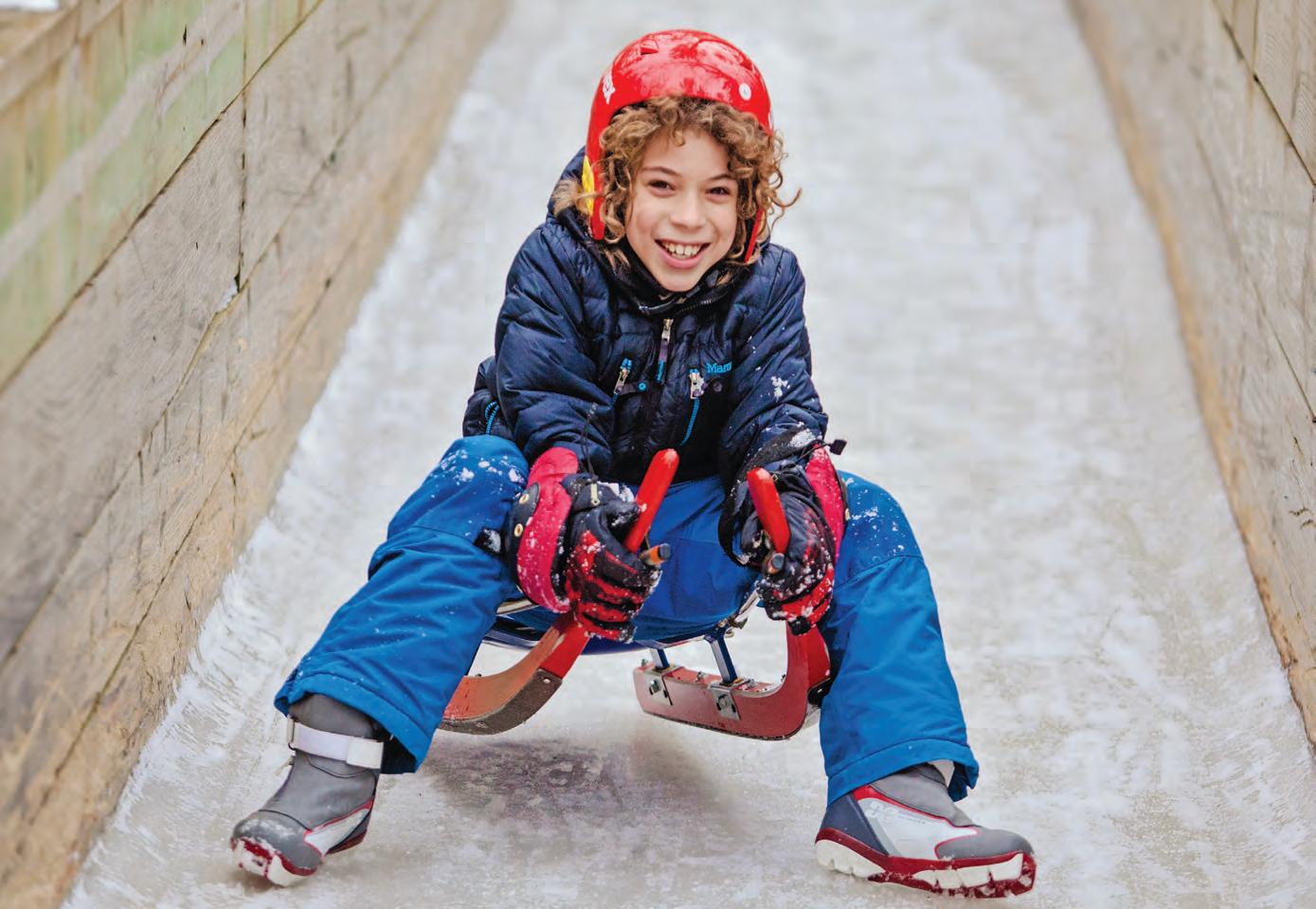




Get ready to discover plenty of welcoming surprises a round this big small town the Dow family built
By Bill SemionWhat would you do on a weekend in this city nicknamed the “home of modern explorers” and “city of beautiful churches”? Turns out there’s a lot, regardless of the season.
If you’re a newcomer, Midland — with just 42,000 residents — will be a pleasant surprise, indoors and out.
Sure, it’s the home of Dow Chemical and Dow Corning, two Fortune 500 companies begun by Herbert H. Dow, who got his start making numerous important products. Midland boasts one of the country’s highest number of Ph.D.s per capita, and its businesses are speeding to the future, working on everything from the next
generation of batteries for autos and homes to bioscience innovations. But it’s a lot more.
There’s Midland’s renowned arts community, new downtown eateries, an aptly named hotel with two restaurants, and outdoor fun that includes part of a multi-use trail that traverses through five counties.
In winter, bring your cross-country skis and museum shoes, and something to wear to the symphony. In summer, bring your bike, kayak, or canoe. In spring, you’ll need a fishing rod and a taste for sweet maple syrup.
In 2020, Midland made national news after upstream dams on the Tittabawassee River failed, devastating nearby towns and partially flooding downtown. Since then, the city and region have made steady progress toward a full recovery.
The Tridge is a popular threespan a ttraction that crosses the Tittabawassee and Chippewa rivers. It connects with the Chippewa Nature Trail, which begins nearby.

There are several hotels and B&Bs in Midland, but my choice is The H Hotel. Yep, H. As in, hydrogen. Only in this city built on lumbering, which then moved on to science, could owners come up with a hotel name — as well as the names of three restaurants — lifted from the periodic table of elements.
The hotel is right in the city’s reshaped downtown. And it’s plain cool, with 130 rooms within walking distance of some great eateries and not far from other things on your things-to-see list. The hotel features three restaurants that continue with the “elemental” theme: the Oxygen Lounge, Café Zinc — CA for calcium, FE for iron, and ZN, as the sign says, for zinc — and One Eighteen, for 118 — the number of periodic table elements. Clever, eh?
In the summer, Main Street from Ashman to Rudd becomes a pedestrian plaza, resulting in the more intimate, relaxed, and quiet experience that many cities are leaning into. The summertime mall will continue at least into 2025.
If you’re in Midland this winter, the first thing to do is head indoors. Check out what’s happening at the Midland Center for the Arts, one of the most comprehensive arts centers in the state and an absolute gem.
The calming H H otel lobby (top) welcomes guests.

The H features three restaurants, including Cafe Zinc (middle), and a stunning staircase (right).


First, there’s the Midland Symphony Orchestra. Its 2022-23 series runs through early May. What about a play? This season’s Broadway & Beyond series features five presentations, including the musicals “Cats” and “The Book of Mormon.”
The Community Theater, at the same venue but within the Little Theatre, features three play choices through early June. The long-running Matrix Midland series, meanwhile, is an eclectic collection of events ranging from talks on science to ballet performances.
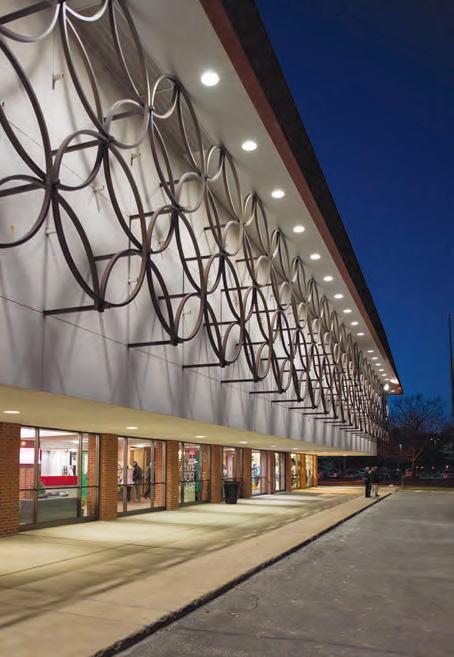

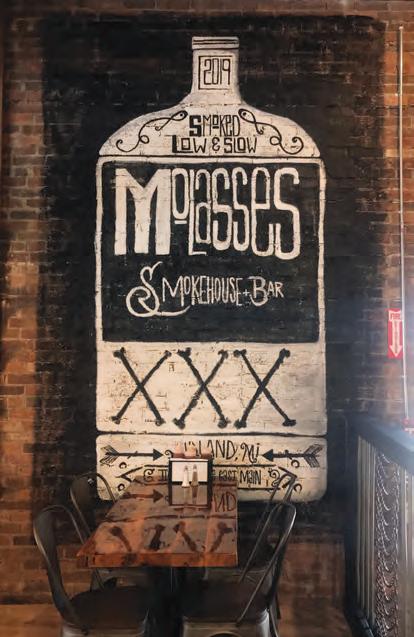
If that isn’t enough, the center’s Windows on the World Series will include a vocal ensemble from Zimbabwe, the Grammy award-winning Sones de Mexico, and Syrian American and First Nations groups through early May. Comprehensive enough?
If art’s your thing, this small town has more surprises. Book at least 24 hours ahead of time, then enter the Alden B. Dow Home and Studio. This Dow (Herbert’s son) focused on architecture and designed more than 70 structures. His home is a National Historic Landmark. Dow is one of the originators of Mid-Century Modern, sometimes called Michigan Modern — and, lucky you, it’s open for tours from February through December.
See some of his work and that of others by d ownloading t he city’s Mid-Century Modern Midland Driving Tour app (all homes on the tour are private, but can be viewed from the road). Not into architecture? You may want to drop a pin downtown at spots like Gratzi Midland, or get sticky fingers at downtown’s Molasses Smokehouse & Bar or, just west of downtown, at the Midland Brewing Co.
Like your fun outside? You got it. If there’s snow, dress for the outdoors and head for Midland City Forest, just north of U.S.-10. There are nearly eight miles of cross-country ski and snowshoe trails, including a .7-mile lighted section, and its 13 miles of mountain bike trails are open year-round. Rental skis and skates are available when the chalet is open. If speed’s your need, try the four iced toboggan runs operating when conditions permit — they provide the rides. Or try the bring-your-own sled, lighted hill.
Start a winter walk at the famous Tridge, which opened in 1981 and barely escaped overtopping during the 2020 flood. Its three spans cross the Tittabawassee and Chippewa rivers. The Chippewa Nature Trail begins there, and is part of 19 miles cut through the woods that are also open for cross-country skiing and snowshoeing. Eventually, the trail takes you to the Chippewa Nature Center, but you’ll get there faster by car. The nature center features, among other things, a sugar house where, on weekends in March, your family can watch as staff collects and boils maple sap, turning it into syrup.
The Tridge also marks the east end of the Pere Marquette Rail Trail, a 30-mile paved path from Midland west to Clare that’s been named to the Rails-to-Trails Conservancy Hall of Fame. It can be part of a longer snowmobiling journey, taking you 90 miles west to Baldwin.
After brunch at one of the city’s restaurants, head to what you couldn’t take in yet. It’s hard to do Midland justice in one weekend, as it’s truly one of Michigan’s most surprising towns — one that’s worth a return visit for kayaking, canoeing, and watching its minor league baseball team, the Great Lakes Loons, in summer.
G reat L akes Bay Regional Convention & Visitors Bureau gogreat.com
The 1,400-foot-long c anopy walk (above) in the Whiting Forest of Dow Gardens is the longest in the nation. Two public outdoor fire pits (left) on Main Street downtown invite visitors and locals to sit and relax.

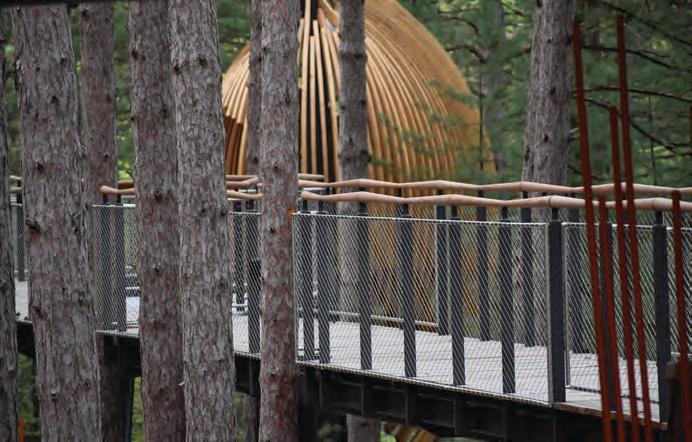
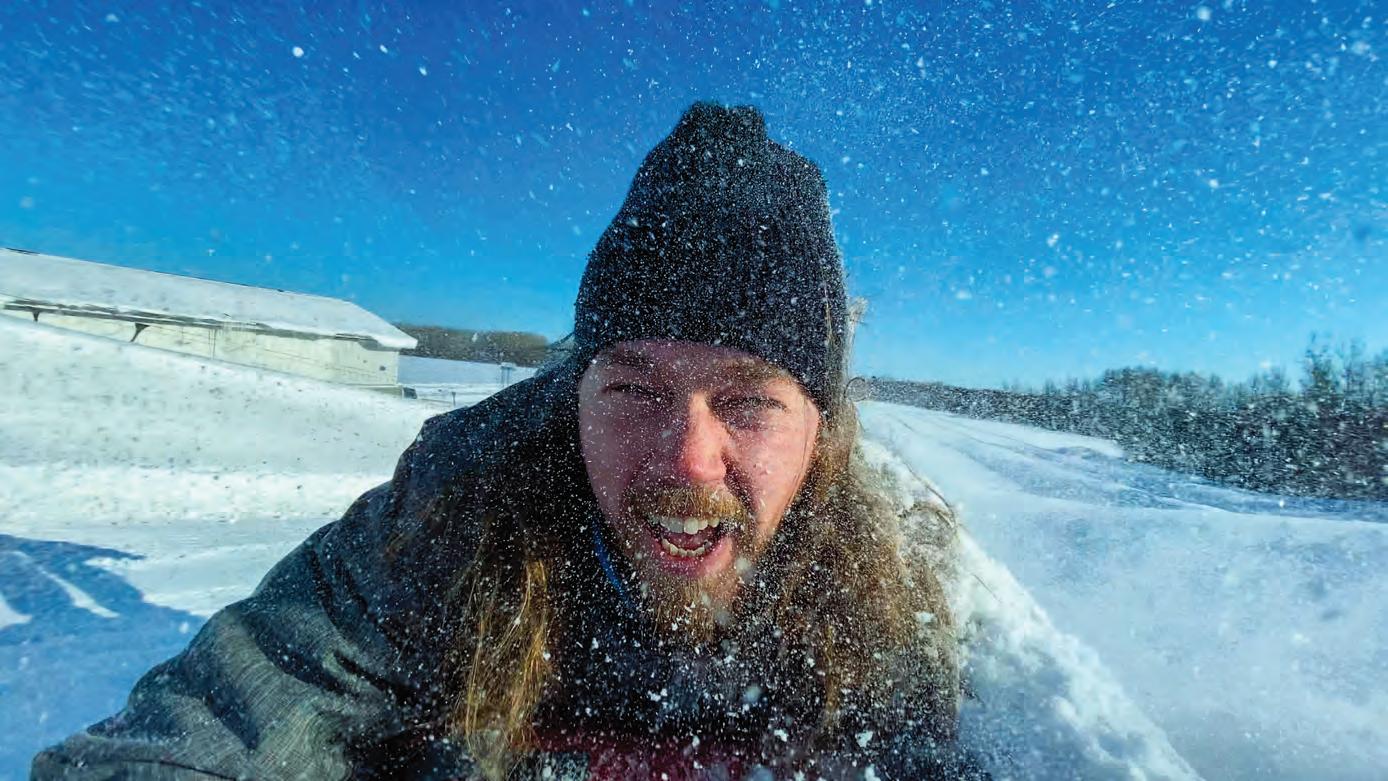 By Amy S. Eckert
By Amy S. Eckert
Clouds of sparkling snow swirl skyward and the buzz of snowmobiles fills the air as 40 racers chase one another around a one-mile oval of ice. Snowsuitand balaclava-clad fans shout to be heard over the roar as they excitedly cheer on the drivers, oblivious to the cold thanks to their thermal gear, woolen blankets, and cups of hot chocolate.
A steady falling snow and a breeze off St. Marys River isn’t enough to dissuade fans from watching the I-500 Snowmobile Race, which for more than 50 years has enticed North American racers to put their grit and determination to the test. Which snowmobiler will earn the status as the
world’s toughest endurance athlete, after completing 500 laps and 500 miles at speeds exceeding 100 mph over the course of eight hours in the middle of February?
If there were any doubt, the I-500 proves the point: Sault Ste. Marie embraces the winter. But you don’t have to be an athlete of racing caliber to appreciate the quality and quantity of cold-weather activities in Michigan’s oldest city, which is home to some 13,500 residents.
Sault Ste. Marie enjoys more than 120 inches of snow annually, thanks to its location on Lake Superior. The region’s vast network of snowmobile trails has turned this part of the Upper Peninsula into an international sledding nirvana.
Winter enthusiasts gladly venture north to Sault Ste. Marie to play in this Lake Superior wonderland.
More than 6,200 miles of trails criss-cross Michigan’s snowy landscape, making the Great Lakes State among the most popular destinations for snowmobilers in the United States. Two-hundred miles of those trails are located within the Sault Ste. Marie area. Beneath snow-laden evergreens and over frozen trout streams, through picturesque small towns and along the Lake Superior shoreline, snowmobilers zip easily over groomed, well-marked trails designed to make exploring by snowmobile as easy as it is by car. Ride past lighthouses like those at Point Iroquois or Crisp Point, cloaked in ice and standing sentinel over the Soo’s frozen stretch of Lake Superior. Power your way atop snow-covered dunes for jaw-dropping views of Whitefish Bay.
Afterward, you can ride right back into Sault Ste. Marie, where snowmobiles are street legal. A 12-foot-wide snowmobile tunnel ushers riders onto downtown Sault Ste. Marie’s city trails. Hotels and restaurants, convenience stores, and shopping venues all welcome customers on sled. Once you reach the evening’s dining and lodging stops, you’re likely to encounter more snowmobiles in the parking lot than cars.
If Sault Ste. Marie is welcoming to snowmobilers, it’s the Upper Peninsula’s natural areas that make the region inviting to skiers and snowshoers.
In winter, the crowds at Tahquamenon Falls State Park shrink dramatically in size. But as temperatures drop and the snow piles up, the park’s trails are transformed into one of Michigan’s most beautiful snowshoe destinations.

top: An extensive network of snowmobile trails transforms the Soo region into an international sledding nirvana. Above: Area hiking trails morph into quiet snowy playgrounds when winter arrives.

Skimming atop the knee-deep snow, snowshoers walk across a smooth blanket of white, marred only by the intricate tracks of winter birds and mice. Gracefully drooping evergreen limbs, heavy with snow, sparkle in the sunshine. Tahquamenon’s famous waterfalls freeze into root beer-colored icicles, and in February you can explore under the stars, when the trails are lit by lantern light.
Lanterns shine on the Soo’s groomed Algonquin cross-country ski trails after dark, too. Carving up the landscape near the Tanglewood Marsh Golf Course, the Algonquin system, and the Sault Seal Recreation Area, both only 10 minutes from downtown Sault Ste. Marie, the trails morph from summertime running and hiking paths to quiet snowy playgrounds when winter arrives.
An easy drive across the International Bridge and the St. Marys River leads visitors on a wintery day trip in Sault Ste. Marie, Ontario. Like its American counterpart, the Canadian Soo embraces many of the winter sports popular on the American side, including snowshoeing, cross-country skiing, and snowmobiling. But the opportunity for a
Above: The root beercolored Tahquamenon Falls are an icy treat to explore when the temperatures dip.

Left: Pristine natural areas provide hidden gems for snowshoers to wander.
little foreign flare and a strong U.S. dollar can make an Ontario getaway especially appealing.
Just north of town, the Hiawatha Highlands ranks as a perennial favorite for Ontario’s winter sports enthusiasts. More than five miles of mixed terrain — the relatively flat and easy Pinder Trails and the hillier, more challenging Crystal Trail — make

it possible to enjoy the beauty of this snowy landscape whether you’re a beginning or an experienced snowshoer.
The Hiawatha Highlands are best known for their 30 miles of finely groomed crosscountry ski trails. Thanks to many generations of active Finnish settlers in this region of Ontario, cross-country skiing has long been part of the culture of a Sault Ste. Marie winter, with plenty of trail access, equipment rentals, and lessons for all abilities.
For magical views of Ontario’s Lake Superior shoreline, head west out of Sault Ste. Marie to the rocky coast near Gros Cap or Red Rock. Here, where Lake Superior is channeled into the narrows of the St. Marys River, the frigid surf splashes and freezes into ice, crumbles, and freezes again, creating fantastical formations. On a sunny day, icy furrows, frozen archways, and small ice caves gleam in the sunlight and reflect the sky’s blue hues. Delicate ice filigree adorns the entrances to tiny ice caverns, and the landscape looks bejeweled.
Spending the day in the snowy outdoors is only half the fun of a winter getaway. The other half is warming up at a toasty hotel or restaurant back on the Michigan side.

Since 1927, the Hotel Ojibway has been welcoming visitors to its location on the banks of the St. Marys River. United States presidents, Olympic athletes, and ordinary travelers have headed to this hotel for a cozy stay overlooking the International Bridge and the Soo Locks.
The Ojibway proudly touts its history, displaying vintage black-and-white photos of the Soo area from a century ago in its common areas. Enjoy dinner in the restaurant’s dining room and look out over Soo Locks Park and across the river to Canada.

There are no river views at Sault Ste. Marie’s Kewadin Casino hotel, but with lavish hotel rooms, spacious suites, and three on-site restaurants, you may not mind. Enjoy a meal at DreamCatcher’s Restaurant, which serves up generous omelette breakfasts and
custom-made burgers, steaks, and local seafood to fuel guests before and after a day in the outdoors. For a more relaxed meal for two, room service is a fine option.
A U.P. landmark and a Sault Ste. Marie casual favorite, Antlers Restaurant is located just a short distance from the downtown riverfront. Simple, substantial meals of hamburgers, BBQ, wild game, and local fish washed down with a Michigan beer satisfy hungry customers. The restaurant’s real claim to fame is its display of more than 200 taxidermied animals — from fish to moose, otters, and lions — which adorn its walls and ceilings.
Above: The Point Iroquois Light, opened in 1870, marks the division line between Whitefish Bay and the western end of the St. Marys River. Left: Icedraped freighters ply the Soo Locks before they close late in the shipping season on Jan. 15 every year.
If you haven’t had your fill of winter yet, bundle up and head to Bird’s Eye Outfitters gastropub. There, igloo dining offers a memorable meal that feels simultaneously indoors and outdoors. The igloo’s walls keep the winter chill out, and the clear walls and ceiling allow one more opportunity to soak up the beauty of a Sault Ste. Marie winter.
S ault S te. Marie Convention & Visitors Bureau saultstemarie.com
You’ll be treading lightly with these desserts, which feature smart recipe substitutes
 By Honey Murray
Photography by Steven Prokuda
By Honey Murray
Photography by Steven Prokuda
The holidays have passed, and you’ve shared many wishes with friends and family for a healthy new year. The start of a new year might even have you diving headlong into new depths of fitness workouts, or considering dietary restrictions.
Perhaps you’ve tread these waters for a few days, or even weeks, but you quickly found yourself washing ashore, feeling overwhelmed and defeated, watching helplessly as your new efforts and resolutions float away, without you, toward the horizon.
Maybe the plan was a bit too drastic, observes Jonathan Serman, M.D., a boardcertified family medicine doctor and certified functional medicine practitioner.
“Fitness and weight loss goals can be reached without severity,” he says. “In addition to good sleep habits and breathing clean air, especially when sleeping, successful weight loss can be achieved in small steps. If you can reduce, just a little, the number of unhealthy things you’re eating and then build on that, you’ll succeed.
“If you have three cans of pop every day, try cutting it down to two for a week. Then, the next week, cut down to one. With changes like that, you’ll be amazed at how soon you’ll see healthy results without being drastic and then backsliding.”
The following dessert recipes are perfect for a cut-back philosophy and will offer you, your friends, and family simple options for healthier, lighter, easy, and really delicious treats. Leftovers will keep well in the fridge for four days, making each an anytime, helpyourself goodie option.
Each selection can also be sweetly
enhanced and decorated with two unique jarred toppings: Salted Maple Caramel and Chocolate Fudge Sauce from Michigan’s own American Spoon (spoon.com), which is celebrating 40 years of working with Michigan farmers to preserve and present their small-batch, sustainably created jams,
jellies, sauces, nut butters, salsas, baking mixes, and much more. American Spoon has locations in Petoskey, Harbor Springs, Traverse City, Saugatuck, and, seasonally, in Charlevoix. Many of their products are also sold in area gourmet retail shops, and all are available from spoon.com.
Ingredients
2 pineapples, peeled. Core, if desired.
2 navel oranges, peeled (including pith)
2 ruby grapefruits, peeled (including pith)
4 clementines, peeled and sectioned
American Spoon Salted Maple Caramel
American Spoon Chocolate Fudge Sauce
Ground cinnamon for sprinkling
1 cup plain Greek yogurt
1 teaspoon honey
Wax paper
One large tray or two medium trays, to hold the fruit that will be sliced or segmented tip for Success
To prevent scorching, heat the opened jar of Chocolate Fudge Sauce on medium stovetop heat, in a small saucepan that’s filled with about 2 inches of water.
Slice the oranges and grapefruits into half-inch slices, and arrange them on the tray, alternating them.
Drizzle the rows with American Spoon Salted Maple Caramel.
Gently warm the American Spoon Chocolate Fudge Sauce (see Tips for Success, above). Dip each mandarin slice halfway into the sauce and lay it on waxed paper. When the segments are dry, arrange them on the tray.
In a small bowl, gently mix the honey into the Greek yogurt. Sprinkle the top with cinnamon. Serve with the tray as an optional topping or dip for the fruit.
Let’s Eat!
This dessert is such a refreshing end to any meal, and the “sunshine vitamin” quality of these fruits is deliciously uplifting. Any leftovers make a great addition to the next day’s breakfast.
Both pages: A delicious fruit tray, rich and flavorful brownies, and sweet little custard cups get rave reviews from partygoers.
This is a lightened-up version of the brownies I served as a former restaurant owner. Ingredients

2 tablespoons vegetable oil, such as safflower, plus more for the pan 4 ounces bittersweet chocolate, coarsely chopped ¾ cup all-purpose flour ½ cup unsweetened cocoa powder ¾ cup dark-brown sugar ½ cup unsweetened applesauce ½ cup plain Greek yogurt 2 large eggs
1 teaspoon vanilla extract
Optional: ½ cup chopped walnuts tips for Success
For the richest flavor, use high-quality
cocoa powder and, to assure their delicious moistness, do not overbake.
Preheat oven to 350 F. Brush a 9-inch square pan with oil and then line it with parchment, with about 2 inches hanging over two sides, and then brush the parchment with oil. In a small bowl in the microwave, on medium setting, heat half of the chocolate pieces, stirring every 30 seconds, until melted.
In a medium bowl, whisk together the flour, cocoa powder, salt, and baking soda. In another bowl, whisk together the brown sugar, applesauce, yogurt, melted chocolate, eggs, oil, and vanilla (and chopped walnuts, if desired) until combined. Add the flour mixture, and mix gently, just until moistened.
Spread the batter into the pan. Sprinkle the top with the remaining chopped chocolate pieces. Bake 30-35 minutes, until a toothpick inserted in the middle comes out with a few moist crumbs attached. Allow the brownies to cool completely in the pan, and then lift them out using the overhanging parchment paper. Peel the paper, and cut into 16 squares.
If your guests desire a bit more decadence, let them drizzle their brownie with American Spoon Salted Maple Caramel or Chocolate Fudge Sauce. If you’d like to serve these alongside a platter, like our Dressed-Up, Fancy Vitamin C Fruit Tray (for those who truly require a bit chocolate for dessert), then cut some of the brownie squares diagonally to form smaller-sized triangle bites.
Using skim milk helps to cut fat when making custard. Of course, topping it with Michigan’s American Spoon caramel is always a good idea.

2 eggs and 1 egg white, slightly beaten 1/3 cup minus 1 tablespoon sugar
1 teaspoon vanilla
1 dash of salt
2 ½ cups skim milk, scalded Ground nutmeg
Six 6-ounce custard cups or ramekins 13 x 9 x 2-inch baking pan tip for Success
When scalding the milk, never have the stovetop heat higher than medium, and stir constantly. The milk is scalded when it’s just below the boiling point, with tiny bubbles at the edges.
Heat oven to 350 F. Mix eggs, sugar, vanilla, and salt in a medium bowl. If you have a bowl with a pouring spout, now is the time to use it! Gradually stir in the milk. Pour into the cups, and sprinkle
each with nutmeg. Place cups into the pan. Pour very hot water into the pan, to within a half-inch of the top of the cups. Bake about 45 minutes, or until a knife inserted comes out clean.
There’s a nutritional beauty to this dessert that makes it perfectly acceptable — and delightful — to enjoy any time of the day or night, or as a light meal on its own, perhaps topped with fresh fruit or, delectably, the American Spoon Salted Maple Caramel. If you’re having guests, it’s easy to make this ahead of time for them to grab for themselves, microwave-warmed or cold. I’m not generally a dessert maker, but am easily able to make this recipe of Big Red’s, although it definitely seems better when she’s the one who’s made it.


















Tubing is just one of the many fun adventures awaiting at Shanty Creek Resort.

Twin brothers expand their growing craft distillery operations in Petoskey and on Mackinac Island.
Bay Harbor’s NOMAD. features shareable taste treats with international influences.
Shanty Creek Resort near Bellaire, with its four-village layout, earns high marks from guests and reviewers alike.
The 17-mile s tretch of Northeast Michigan’s M-13 route offers an inviting collection of quirky and interesting stops.
It’s a marriage of marketing and good spirits: a rum that tastes like Mackinac Island.
“It’s our 8-year style; it’s going to be not too sweet; it has a little smoke in it, you can pick up a little fudge taste, but mostly it drinks like a bourbon,” Adam Kazanowski says of his company’s aged rum. Adam, along with his twin brother, Michael, are the founders of the Mackinac Island Rum Co. tasting room. The hint of Original Murdick’s Fudge is a nod to Mackinac’s heritage.
Stop in at the tiny bar on Main Street near The Haunted Theatre and you’ll find yourself in a Caribbean-style tiki bar. At just 600 square feet, with small windows looking out to the ferry docks, the tasting room has a bar constructed of bamboo, with bright orange and blue décor. There are a few high tops for sitting. Dollar bills left by patrons dangle from the ceiling and walls,
most of them signed by the customers. The bar serves only spirits made by its parent company, High Five Spirits, a craft distillery in Petoskey.
For $6 you can sample four rum flavors the 8-year, vanilla cinnamon, banana, and coconut — plus Petoskey Stone gin and Gypsy vodka. “If you buy the bottle, the tasting is free,”Adam Kazanowski says.

The tasting room opened in summer 2021. It operates during the tourist season, from April to October, on the elegant island in Lake Huron. Mackinac Island’s claim to fame is that no motorized vehicles are allowed; instead, you hear the clip-clop of horse hooves and dodge bicycles and pedestrians in town.
The most popular drink at the tiki bar is the Pain Killer, a mixture of rum, cream of coconut, orange juice, and nutmeg. Other summery drinks include Rum Punch, Pina Colada, and Michigan Sunrise.
Yes, there are some challenges to having a bar on an island that allows no vehicles. Three times a summer, High Five Spirits ships 200 to 300 bottles of spirits to the island by ferry, then has to bring a horse-drawn wagon down to the dock to transport them to the bar.
Kazanowski, his brother, and operations director Michael Kolkmeyer spent a few years convincing the famously strict Mackinac Island business community that their Michigan-centric tiki bar idea was a good one. Although the island has a serene 19th century esthetic,“you also have a lot of sailors and people from all over the world who are on vacation,” Kazanowski says. What better than the Mackinac spirit to promote a Michigan spirit?
The Kazanowskis’ journey to their Mackinac venture is a winding tale.
A decade ago, the brothers, who grew up in the Detroit suburb of Birmingham, moved
this page: The tiny Mackinac Island Rum Co. tasting room on Main Street offers $6 samples of four flavors, including the 8-year, vanilla cinnamon, banana, and coconut rums, plus Petoskey Stone gin or Gypsy vodka. Opposite page from left: Michael Kazanowski , Michael Kolkmeyer, and Adam Kazanowski launched the Petoskey-based distillery.
to Breckenridge, Colo., after graduating from Michigan State University. They became fascinated with the idea of distilling vodka and learned the ropes from a local expert. Three years of working at music festivals and living in their van let them save up $50,000 — enough to launch their own company, Gypsy Vodka, on a shoestring. They named their product Gypsy for a reason.
“Gypsy, to us, means a love of freedom and adventure. We don’t celebrate the enjoyment of life enough. It’s a celebration of what life is,”Adam Kazanowski explains.
Eventually the brothers moved their operations to Michigan, opening their Petoskey-based craft distillery in 2017 and rebranding it as High Five Spirits. It makes vodka, rum, gin, and canned cocktails, plus The Mulligan, an Arnold Palmer with vodka. The Petoskey location operates year-round as a tasting room, with live music and food vendors.
After a brief expansion lull during the pandemic, High Five added the Mackinac Island Rum Co. tasting room in 2021. Then, last September, it took a really big step — opening Gypsy Farms in Petoskey. With 23 acres, a view of Lake Michigan, and a rustic 42,000-square-foot former equestrian center as its new facility, there’s room for tastings, meals, distilling, weddings, and events.
“We’d been looking in the Bay Harbor area and we wanted something with a view,” Kazanowski says. When the brothers saw the equestrian center, “we walked around and
thought, this could be Michigan’s premium bourbon house.”
So far, Gypsy Farms has opened a tasting room and offers meal service. It has an indoor “cocktail garden” where the old riding arena used to be. Some weddings and events have already taken place, and “we want to host events here, and tours,”Kazanowski says.
The company now has 22 employees and three locations, but it has even bigger goals. In the next three years, it plans to add tasting rooms in both Traverse City and Detroit.
“For now, our focus is hyper-local,” Kazanowski says. “By focusing on Michigan
themes, it’s a good way for us to build fans in our home state, then in other states. We want to put Michigan spirits on the international stage. We want people to recognize Michigan isn’t just known for beer, but for spirits.”
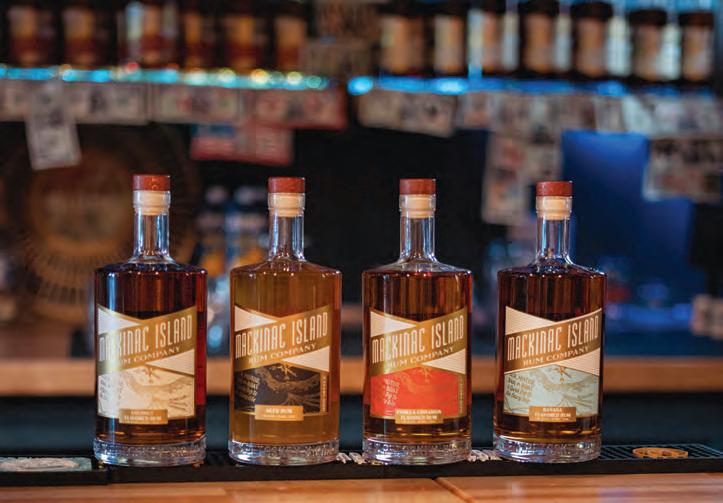
High Five brands are sold in restaurants and retail stores throughout Michigan. But your best introduction may be to stop by a little, laid-back tiki bar on Mackinac Island.

High Five Spirits gypsyvodka.com
NOMAD.
By Dianna StampflerNot all who wander are lost; those who meander with meaning are sure to pick up nuggets of culture along the way from traditions to music, dress, and cuisine. This free-spirited worldly influence is exactly what the leadership at NOMAD. in downtown Bay Harbor was going for when they opened the restaurant’s doors last May.

It’s the second eatery operated by the Morrison family in this small community along the southern coast of Little Traverse Bay (less than five miles from downtown Petoskey); Maple + Batter opened down the block from NOMAD. in July 2021. Twin brothers Bryant and Philip Morrison, and their wives, Jamie and Laura, respectively, are principal owners of both places, under the umbrella of Ross Restaurant Group.
“The name NOMAD. embraces both our style of menu (with international influence and continuous change) and a new age dining experience where guests are encouraged to taste their way through the menu, sharing every dish,”Philip explains. “We consider the style of our restaurant to be a ‘social dining
experience.’ To us, that means come as you are, enjoy, relax, and share. As a guest, allow yourself to settle in, feel at home, and engage in the experience.”
Executive Chef Eric Basta began his culinary career in Detroit at Opus One in the late 1990s. Since then, he’s enhanced his passion and honed his skills at restaurants nationwide, including notable locales such as Jackson Hole, Wyo.; Park City and Deer Valley, Utah; Chicago; and Detroit. His flair for unique ingredients, distinct flavors, and creative presentation have become his signature, and he says he draws inspiration from American, French, Asian, and Italian fare.
The seasonal tapas-style menu is divided into small plates and snacks, as well as featured salads and entrees, most meant for sharing. While some selections may sound familiar, the preparations are unabashedly all Basta.
Among the winter features are foie gras PBJ seared foie gras on toasted brioche with blackberry jam; a double-patty Wagyu cheeseburger with American cheese, dijonaise, peppered bacon, and farm egg;
and bao buns (pronounced “bow”) — sweet, white steamed dough buns stuffed with pork belly, pickled cucumber, and onions, and drizzled with hoisin sauce. They’re currently the most popular item on the menu.
While many area restaurants serve Great Lakes whitefish, perch, or walleye, Basta prefers the distinct style of branzino (a mild European white fish) that he roasts and serves whole with puttanesca, citrus pesto, and charred lemon.
Mary and John Leese, who have a home in Bay Harbor, have enjoyed dining at NOMAD. a handful of times since May. “We split the antioxidant salad, which is so good,” Mary says of one of their summer favorites. “The last time we were there we had the shishito peppers, and they were amazing. John loves the tuna tacos. I’ve also enjoyed the spicy sausage rigatoni and the brown butter agnolotti.” When it comes to dessert, Mary recommends the trio of gelato, when available.
Beyond the food, NOMAD. offers signature cocktails such as its Harvest Cider Mill, crafted with Van Gogh Dutch caramel

Bay Harbor’s
celebrates a world of socially inspired t aste treats designed around a shareable dining experience
vodka and local apple cider, and served in a cinnamon-sugar-rimmed glass, or the Maple Old Fashioned with Bulleit Bourbon, black walnut bitters, maple syrup, and a touch of orange peel.
Local distiller High Five Spirits is also prominently featured with its Gypsy Vodka, Mackinac Island rum, and Petoskey Stone gin. Craft beer from Michigan breweries such as Short’s, Petoskey Brewing, Right Brain, and Dragonmead, as well as an evolving and elevated wine list, round out the beverage menu.
Oenophiles (wine connoisseurs) will love the personal wine lockers, which are available for an annual lease. Each of the 50 units holds up to 12 bottles; owners can bring in their own vintages to enjoy on site without paying an added corkage fee.
Guests can receive discounts on bottles of wine through NOMAD., with guidance available from the restaurant’s general manager, operating partner, and Level 3 advanced sommelier, Colin Brown.
The restaurant offers a variety of dining spaces for couples and groups alike, with intimate tables for two or communal tables that support the social dining concept. Inside, the capacity is about 100 between the tables, banquettes, 12-seat bar, and private dining room. An intimate seating area surrounds a built-in gas fireplace — sure to be a popular spot on blustery northern Michigan winter evenings. In the summer, an additional 120 seats are available on the patio, overlooking a 111-slip marina.
NOMAD is open seven days a week, yearround. A daily happy hour runs from 4:30 to 6 p.m., with half off select small plates, snacks, and drinks, as well as 10 percent off bottles of wine. There’s talk of adding lunch service and a pizza bar in 2023.

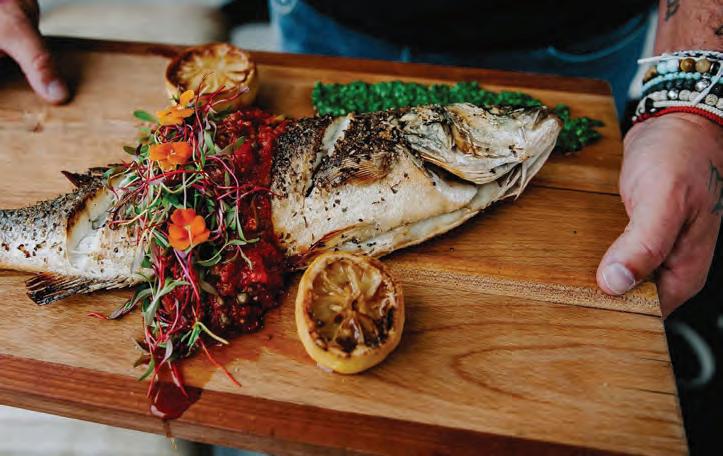
NOM AD. nomadbayharbor.com
this page: Menu items range from pork belly bao buns (top), and a whole roast branzino fish dish (middle) to a delightful selection of shareable plates (bottom). Opposite page: NOMAD., which opened in early 2022, features an easygoing, comfortable atmosphere for dining and relaxing.

When it’s time to enjoy some snowy fun or just unwind, Shanty Creek Resort — ranked No. 2 on SKI magazine’s list of the Midwest’s best ski resorts — offers a mix of top-notch options.

This sprawling, 5,500-acre playground for all ages, located just outside Bellaire in northwest lower Michigan, transforms into a true winter wonderland during colder months.
Its four-village layout sets Shanty Creek apart from the competition. Summit Village, Cedar River Village, and Schuss Village are home to a lengthy list of winter activities, while Hawk’s Eye Village features Shanty Creek’s newest golf course. Shuttles provide transportation between the villages.
“Each village has its own personality, similar to how Walt Disney World has
different villages,” says Lindsey Southwell, Shanty’s marketing director. “All together, the villages offer almost eight square miles of different lodging options, dining venues, and out-the-door recreation. Variety is the spice during the winter months here, with plenty to do on and off the slopes.”
Summit Village occupies land that was the original resort, which was known as Summit Mountain when it opened in 1967. Today, it includes The Lakeview Hotel, overlooking Lake Bellaire; the alpine tubing park; a fitness center; and an indoor heated pool. The Shanty, an inviting bar and grill, is a popular hangout.
Schuss Village, with its distinct Bavarian vibe, is home to the steeper ski runs of Schuss Mountain, as well as cross-country ski trails. Dogsledding also begins there. Ivan’s Cafe is a popular spot for taking a break from skiing or snowboarding to grab a bite.
Cedar River features additional Nordic ski trails, in addition to a trail for snowshoeing and fat-tire biking. Convenient ski-in-andout accommodations near Schuss Mountain include The Lodge, with its large, all-suites format and slope-side condos.
Shanty Creek garners lots of upbeat reviews from the media and guests. In a recent story, for example, award-winning travel journalist and Matador Network senior editor Tim Wenger called Bellaire the Great Lakes region’s “most epic ski town,” with Shanty Creek Resort being a major reason why.
“It offers two connected ski hills and the best tree skiing in northern Michigan,” he wrote. It’s all about the full experience, Wenger said, explaining that there’s no better place to experience après culture for the first time than Shanty Creek. “Bellaire and Shanty
Creek bring a welcome dose of European ski culture to the Midwest,” he noted.
That get-outside-and-play culture centers around 42 downhill ski runs, 25 kilometers of Nordic trails, five terrain parks, an alpine tubing park, dogsledding, snowshoeing, heated outdoor and indoor pools, and more. Some extras: easy access to nearby trails for fat-tire biking and snowmobiling, as well as ice fishing on bodies of water that comprise Antrim County’s legendary Chain of Lakes. Shanty Creek guests also can explore downtown Bellaire via a complimentary shuttle.
Shanty Creek’s downhill terrain was named best in the Midwest by onthesnow.com. The resort’s eight lifts service 400 skiable acres, 69 percent of which contain runs suitable for intermediate and more advanced-level skiing.
Summit Mountain at Summit Village offers gentler, easier, and less crowded runs, while Schuss Mountain’s runs are more challenging — consider the iconic Kingdom Come drop and its 450 feet of vertical and face so steep, the bottom isn’t visible from the top.

Children’s and adult ski lessons are also available from Michigan Ski Coach Hall of Famer Rick Vantongeren and his team. In addition to a traditional bunny hill for beginners, there’s a hill for novices that more closely resembles conditions on regular runs.
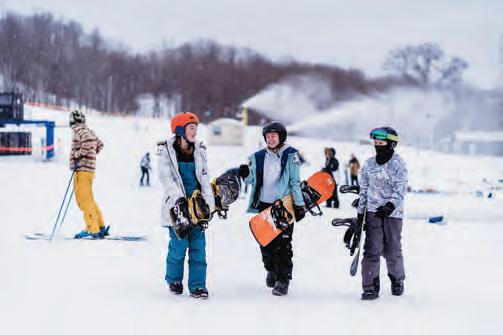
At the terrain parks, the biggest air can be caught at The Monster Park, which is full of rails, boxes, and booters. The Natty uses allnatural elements to form features like rainbow rails, tabletops, and jumps, while Low Rider is for beginners.
this page: The Bavarian-themed Shuss Village (above) is home to the resort’s steepest downhill runs.
Snowboarders (left) can catch the biggest air at The Monster Park. It’s full of rails, boxes, and booters.
Opposite page: Snowboarders often enjoy hours of action at the five terrain parks and on the resort’s variety of ski runs.
biking trails can be found at nearby Glacial Hills Pathway.
Something Different: Second Chance Mushers, a dog rescue organization, offers 20-minute dogsled rides, and meet-andgreet and photo opportunities with the dogs. Rides can be booked online.
Rated the Midwest’s best resort for lodging and dining by SKI magazine, Shanty Creek offers roughly 275 lodging options, including guestrooms, parlors with whirlpools or kitchens, one- and two-bedroom suites, multi-bedroom condominiums, and homes that sleep up to 24.
Shanty Creek Resort shantycreek.com
“All of Schuss Mountain’s chairlifts meet at the top of the hill, making it an ideal location for families,” Southwell says. “Each family member can take the run that suits them best, and then everyone meets back up at the top.”

Rated among the Midwest’s top 10 crosscountry skiing areas by SKI magazine, 28 kilometers of groomed, track-set trails run through all four villages, and meander in tranquil forests and along creeks. The White Pine Stampede Trail offers long glides, while the King of the Hill trail winds around the circumference of Schuss Mountain and can be serviced by snowmaking equipment if needed.
Rentals, lift tickets, and passes for both downhill and cross-country skiing can be booked online.
The eight-lane Alpine Tube Park offers the thrill of downhill sledding without having to climb back up, thanks to its Magic Carpet. The hill’s final two hours of operation on Fridays and Saturdays are reserved for adults only.
A three-kilometer groomed, multipurpose trail at Schuss Village is designated for fattire biking and snowshoeing. Snowshoers can also forge their own trails, while miles of

From top: Family ski outings, snowshoeing with a significant other along a quiet forest trail, or venturing out on a robust dogsled ride are among the many winter activities available at the four villages of Shanty Creek Resort.




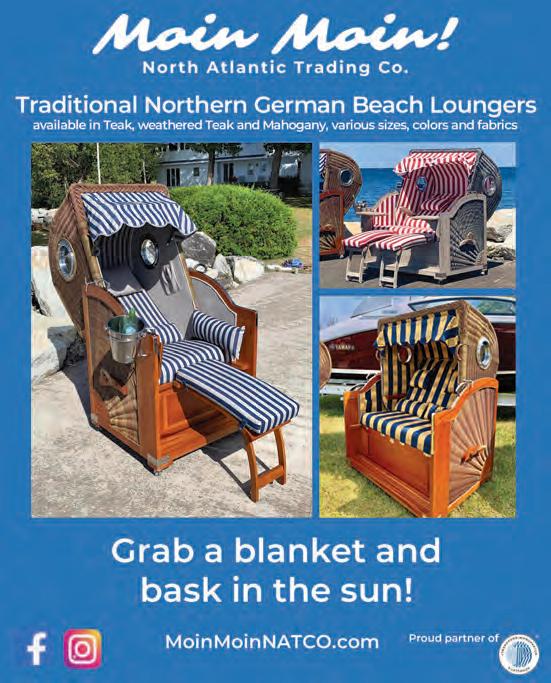
In the early 20th century, author Thomas Wolf famously said, “You can’t go home again.” I humbly beg to disagree.
Time is elastic. It wrinkles, bends, expands, contracts. My most recent trip down M-13, also called Old U.S. 23, between Bay City and Standish in east Michigan, proves that you can, indeed, go home, and bend memory toward today.
This 17-mile stretch of highway was once the only way to drive into northeast Michigan. I’ve traversed it since I was a youngster enjoying watching things whiz by my window in the back seat of my parents’ Ford sedan, heading to another Tawas-area summer vacation. It hasn’t changed much but yet, it has.
Come along with me this time, as my passengers — and perhaps on your next journey to the sunrise side, you’ll make the time to take the M-13 exit off I-75 and discover some of the quirky and interesting stops on this old Michigan road.
Just north of the point where M-13 turns into a four-lane, the Turkey Roost has been serving inexpensive plates of real roast turkey and all the fixins since I was 8. It’s hard to miss. Just look for the pink building on the east side of the road, near Kawkawlin. It’s on its fourth owner, Austin Ballor, son of past owner Todd, who’s still there.

“We go through about 3,500 38- to 40-pound birds a year,” Todd says. The turkeys are roasted whole and always with the same promise: Turkey at your table within minutes. Sometimes, in seconds. Todd says the most popular item is the original Turkey Plate. It’s comfort food, through and through. The Turkey Roost also serves breakfast, Friday fish, and pies from our next stop.
Pat Schnell and sister RoseAnn named this place after their mother 23 years ago, and Pat is still behind the counter preparing and selling up to 2,000 pies weekly. She admits

to having a little help from friends and relatives at holiday time, when customers are lined out the door.
And, yes, that’s 2,000. The most popular varieties are Dutch apple and pumpkin, but you’ll almost always find blueberry, raspberry, meringue, and even peanut
I’ll take the old road and enjoy a little time traveling a long northeast Michigan’s M-13
SemionThe Turkey Roost (top) is a frequent stop for locals and travelers on M-13. Rosie’s Pies & Bakery (below) makes more than 2,000 pies every week.
butter among the dozen types of pies available daily.
Schnell also makes custom pies on request. Regardless of type, they’re all $17. It’s simpler with one price, she says. The shop also supplies the local Jack’s Fruit & Meat markets.
Directly on Saginaw Bay, the marina is open year-round for boating or fishing, both soft and, in winter, the hard-water variety, when ice-up occurs. The bay promises some of the world’s best walleye fishing, and you can book a charter here and stay at the Linwood Beach campground.
The side of the bright blue building says 60,000 hubcaps, and owner John LeGendre knows where each one is. Need a hubcap for an auto restoration? Lose one in a pothole? This is the place.
LeGendre has caps dating from 1948, including one rare Cord cap. He even sells over the phone. He’s usually open four days a week, but when the large garage door is up, he’s there.
The company founded by Jim and Jenny Williams in 1946 churns out more than 5 million pounds of spreads annually, including a horseradish cheese that just won the gold medal in a world competition in Wisconsin. Williams also sells other cheeses and those squeaky curds.
When we kids passed Frank’s Bait & Tackle, as it used to be called, we knew we were almost “Up North.” Frank’s has grown a lot since then, and now sells outdoor clothing, gifts, and such, and recently expanded its fishing department.

I rely on their recorded fishing reports from Capt. Andy Gorske, grandson of Frank, who founded it in 1945. Today Andy and his brother, Pete, carry on.
The place that “makes the outdoors affordable” has been a Pinconning fixture since two brothers moved the business in 1999 into a 75,000-square-foot building. It’s now more than 90,000 square feet, and sells everything from trailer tires to cheese.
The establishment’s biggest draw is the fishing department, which sells rods, reels, lures, electronics, and, in season, 4,000 to 5,000 dozen night crawlers weekly.
Looking for a lost hubcap? Check out J ohn’s Hubcap Sales (left) for almost any style. A stop at Wilson’s Cheese Shoppe (below) is a family tradition for many vacationers. Bearded Capt. Andy Gorske (bottomleft) and his brother, Pete, run Frank’s Great Outdoors, which was begun by their grandfather.
In summer, 10,000 kayaks leave the lot, and in fall, it’s truckloads of bird seed. Bigfoot is the store mascot, and its billboards advertising seasonal deals decorate highways from Indiana to just south of town, reports Northwoods director Bob Wozniak.

I can still remember the burgers at Pinconning’s Purtell’s, and its house-made ice cream — including my family’s favorites, chocolate revel and butter pecan. The dairy in back may be gone, but the food and ice cream have been staples here since 1925.

Kathy Purtell is currently in charge, after taking over from her parents years ago. Don’t forget the malts and shakes!
Look for the big mouse and cheese wedge atop the building on Pinconning’s north side, and you’ve found it — right in the town where Pinconning cheese, a type of
Colby, was invented when dairy farmers here needed to do something with their extra milk.

Wilson’s has been selling Pinconning cheese — from its biggest seller, mild, to 10and 15-year extra-extra-extra sharp — since 1925. There’s a great selection of wines, too, in addition to other treats. “We’re a lot of people’s half-way stop north,” says manager Ryan Kleinhans. “We have something for everybody’s taste levels.”

If you just can’t get enough cheese, the Pinconning Cheese Co. & Fudge Shoppe has been across the street since 1948. The town hosts its annual Cheese Festival each June.
















You’re nearing Standish now, where M-13 again becomes U.S. 23. At Worth Road, turn east, and if you’re ready for a break, head to this hot spot just off Saginaw Bay. The hotel is next to the casino, and there’s camping, too.


















This is one of the last of many such roadside markets that once lined M-13 from Bay City to Standish. You can stock up on everything from veggies to meats for the rest of your journey.
M-13 may end here, but this is only a glimpse of what’s in store when you leave the freeway and explore, both in your mind and in your vehicle.


Ready to try your luck? Saganing Eagles L anding Casino is a short drive off M-13.


To capture January-morning colors, this northeast Michigan photographer was ready for the perfect shot about 20 minutes before the sun rose Text and Photo by Shelley Goodlaski

My favorite childhood memories a re of Lake Huron in Oscoda. My aunt, uncle, and cousins would spend the entire summer on the lake. I remember thinking how lucky they were, and looked forward to visiting them every summer. My cousins and I tied inner tubes together and floated in the lake for hours. Some days we would take the boat down the AuSable River, climb a huge sand dune, and then run down into the river. Every day was a new adventure, whether we were swimming or collecting stones, beach glass, or shells. Making a visit to the Red Barn to pick out the perfect souvenir also was high on our list.
When I met my husband, Michael, I discovered that his family owned a cabin in Oscoda, too. Within a couple of years, we purchased our own. Fast-forward several decades, and we purchased a house on
Lake Huron. In 2020, Michael retired after 35 years at Chrysler and we sold our home in metro Detroit to become permanent Oscoda residents. This past summer, we celebrated 35 years of family reunions there. Four generations of family rent cabins on the beach; they arrive from all over the U.S. and as far away as Germany.
Every morning offers a beautiful landscape when you live on Lake Huron — the sunrise side. Each season brings different colors that you won’t see if you only visit in the summer. On one cold January morning, my cat, Chief, and I went down to the beach during the blue hour, which is about 20 minutes before sunrise. I had my Sony a7R lll camera and a Sony wide-angle lens with a filter with me. There was enough light that I could take a photograph without using a tripod.
The clouds made a beautiful pattern that you just don’t see every day. The only
sound was the wind, as the shoreline was frozen and the water was still. As the first light appeared, the clouds lit up in shades from orange to purple. I knew, as I took my first shot, that this sunrise would be special. I’m so fortunate to live on Lake Huron and see the beautiful light show that Mother Nature provides.
P.S. One of the prettiest public places to view a Lake Huron sunrise is at Oscoda Beach Park in downtown Oscoda. The park features a long boardwalk, a sandy beach, and a pier. The lake floor is gradually sloped and shallow for quite a distance, making it an ideal beach for swimming. Just north of here is Three Mile Beach Park, another great option. This park, running alongside U.S.-23, offers thousands of feet of sugar sand beach and multiple access points along the east side of the roadway. Use one of a few turnoffs just north of downtown Oscoda. Check out oscoda.com for more information.













